


+ EXTREME E
GERMAN
NEWS • REVIEWS • INTERVIEWS • ELECTRIC CARS • ELECTRIC SCOOTERS • E BIKES
THE LATEST IN ENTER THE ACTIVESPHERE THE LATEST CONCEPT EV FROM
MANUFACTURER, AUDI
MARCH 2023 FREE &
More and more businesses are using smart meters to help them feel more in control of their budgeting.





Smart meters send gas and electricity readings straight to their supplier. So rather than estimates, Frank here knows he’ll receive accurate energy bills. And that means he’ll know exactly how much he’s spending each month. Search ‘get a smart meter’ today.

Eligibility may vary. ALBERT EINSTEIN rights licensed by The H.U.J./Greenlight. S S SS S S S S S S S S S S S S S S S SS S S S S S S S S S S S S S S S S SS S S S S S S S S S S S S S S S S S SS S S S S S S S S S S S S S S S S S S S S S S S S S S S SS S S S S S S S S S S S S S S S SS S S S S S S S S S S S S S SS S S S S S S S S S S S SS S S S S S S S S S S SS S S S S S S S S S SS S S S S S S S SS S S S S S S S S S S S S S S S SS S S S S S S S S S S S S S S SS S S S S S S S S S S S S SS S S S S S S S S S S S S S SS S S SS S S S S S S S S S S S SS S S S S S S S S S S S S S S S SS S S S S S S S S S S S S S S S S S SS S S S S S S S S S S S S SS S S S S S S S S S SS S S S S S S S S S S S SS S S S S S S S S S S S S SS S S S S S S S S S S S S S SS S S S S S S S S S S S S SS S S S S S S S S S SS S S S S S S S S S S SS S S S S S S S S S S S S S S SS S S S S S S S S S S S S S SS S S S S S S S S S S SS S S S S S S S S S S S SS S S S S S S S S S S S S S S S SS S S S S S S S S S S S S S S S SS S S S S S S S S S S S S S S S SS S S S S S S S S S S S SS S S S S S S S S S S SS S S S S S S S S SS S S S S S S S S S S S S S SS S S S S S S S S S S S S S S SS S S S S S S S S S S S S S SS S S S S S S S S S S S S S SS S S S S S S S S S S S S S SS S S S S S S S S S S S S S S SS S S S S S S S S S S S S S SS S S S S S S S S S S S S S SS S S S S S S S S S S S S S S SS S S S S S S S S S S S S S S SS S S S S S S S SS S S S S S S S S S S S S S S S S SS S S S S S S S S S S S S S S S S S SS S S S S S S S S S S S S S S SS S S S S S S S S S S S S SS S S S S S S S S S S S S S S SS S S S S S S S S S S S S S S SS S S S S S S S S S S S S S S SS S S S S S S S S S S S S S S S S SS S S S S S S S S S S S S S S S S S SS S S S S S S S S S S S S S S S S S S SS S S S S S S SS S S S S S S S S S S S S SS S S S S S S S S S S S SS S S S S S S S S S SS S S S S S S S S S S SS S S S S S S S S S S S S S S S S S SS S S S S S S S S S S S S S S S S SS S S S S S S S S S S S S S S SS S S S S S S S S S S S S SS S S S S S S S S S S S SS S S S S S S S S S S S S SS S S S S SS S S S S S S S S S S S S S SS S S S S S S S S S S S S S S S SS S S S S S S S S S S S S S S S SS S S S S S S S S S S S S S SS S S S S S S S S S S SS S S S S S S S S S S SS S S S S S S S S S S S SS S S S S S S S S S S S S S SS S S S S S S S S S S S S S S S SS S S S S S S S S S S S S S S S S S S S S S S S S S SS S S S S S S S S S S S S S S S SS S S S S S S S S S S S S S S SS S S S S S S S S S S S S S SS S S S S S S S S S S S S S SS S S S S S S S S S S S S S S S S SS S S S S S S S S S S S S S S S S SS S S S S S S S S S S S S S S S SS S S S S S S S S S S S S S S S S SS S S S S S S S S S S S S S S SS S S S S S S S S S S SS S S S S S S S S S S S SS S S S S S S S S S S S S S SS S S S S S S S S S S S S SS S S S S S S S S S S S S S S SS S S S S S S S S S S S S S S S S SS S S S S S S S S S S S S S SS S S S S S S S S S S S S S SS S S S S S S S S S S S S S SS S S S S S S S S S S S S S SS S S S S S S S S S S S S SS S S S S S S S S S S S S S SS S S S S S S S S S S S S S S S S S S S S S S S S S S SS S S S S S S S S S S S S S S SS S S S S S S S S S S S S S S S S SS S S S S S S S S S S S S S S S S S SS S S S S S S S S S S S S S S S S S S S SS S S S S S S S S S S S S S S SS S S S S S S S S S S S S S S SS S S S S S S S S S S S S S S SS S S S S S S S S S S S S S S SS S S S S S S S S S S S S S S S S SS S S S S S S S S S S S S S S S S S SS S S S S S S S S S S S S S S S S S SS S S S S S S S S S S S S S S S S SS S S S S S S S S S S S S S S SS S S S S S S S S S S S S S SS S S S S S S S S S S S SS S S S S S S S S S S S S SS S S S S S S S S S S S S S S S S S SS S S S S S S S S S S S S S S S S S SS S S S S S S S S S S S S S S S S S SS S S S S S S S S S S S S S S SS S S S S S S S S S S S S S SS S S S S S S S S S S S SS S S S S S S S S S S SS S S S S S S S S S S SS S S S S S S S S S S SS S S S S S S S S S S S S S SS S S S S S S S S S S S S S S SS S S S S S S S S S S S S S S S S S S S SS S S S S S S S S S S S SS S S S S S S S S S S SS S S S S S S S S S S SS S S S S S S S S S S S SS S S S S S S S S S S S S S SS S S S S S S S S S S S S S S SS S S S S S S S S S S S S S S S S SS S S S S S S S S S S S S S S S S S SS S S S S S S S S S S S S S S S SS S S S S S S S S S S S S S S S SS S S S S S S S S S S S S S S SS S S S S S S S S S S SS S S S S S S SS S S S S S S S S S S S S S S SS S S S S S S S S S S S S S S S S SS S S S S S S S S S S S S S S S S S SS S S S S S S S S S S S S S S S SS S S S S S S S S S S S S S S S SS S S S S S S S S S S S S S S S SS S S S S S S S S S S S S S SS S S S S S S S S S S S S S SS S S S S S S S S S S S S S SS S S S S S S S S S S S S S SS S S S S S S S S S S S S SS S S S S S S S S S S S SS S S S S S S S S SS S S S S S S S S S S S S S S S SS S S S S S S S S S S S S S SS S S S S S S S S S S S S S SS S S S S S S S S S S S S S SS S S S S S S S S S S S S S SS S S S S S S S S S S S S SS S S S S S S S S S S S S S SS S S S S S S S S S S S S S S S SS S S S S S S S S S S S S S S SS S S S S S S S S S S S S S S SS S S S S S S S S S S S S S S S S SS S S S S S S S S S S S S S S S SS S S S S S S S S S S S SS S S S S S S S S S S S S SS S S S S S S S S S S S S S SS S S S S S S S S S S S S S S S SS S S S S S S S S S S S S S S SS S S S S S S S S S S S S S S SS S S S S S S S S S S S S S S S S SS S S S S S S S S S S S S S S S S S SS S S S S S S S S S S S S S S S S S SS S S S S S S S S S S S S S S S S SS S S S S S S S S S S S S S S S SS S S S S S S S S S S S S S SS S S S S S S S S S SS S S S S S S SS S S S S S S S S S S S S S S S S SS S S S S S S S S S S S S S S S S SS S S S S S S S S S S S S S S S S S SS S S S S S S S S S S S S S S S S SS S S S S S S S S S S S S S S S SS S S S S S S S S S S S S S S SS S S S S S S S S S S S SS S S S S S S S S S S SS S S S S S S S S S S SS S S S S S S S S S S S SS S S S S S S S S S S S S SS S S S S S S S S S S SS S S S S S S S S S S S S S SS S S S S S S S S S S S S S S SS S S S S S S S S S S S SS S S S S S S S S S S SS S S S S S S S S S S SS S S S S S S S S S S S SS S S S S S S S S S S S S SS S S S S S S S S S S S S S SS S S S S S S S S S S S S S S S S SS S S S S S S S S S S S S S S S S S SS S S S S S S S S S S S S S S S SS S S S S S S S S S S S S S S S SS S S S S S S S S S S S S SS S S S S S S S S S S S SS S S S S S S S S S S S S SS S S S S S S S S S S S S S SS S S S S S S S S S S S S S S S S SS S S S S S S S S S S S S S S S S S SS S S S S S S S S S S S S S S S SS S S S S S S S S S S S S S S S SS S S S S S S S S S S S S S S S SS S S S S S S S S S S S S S SS S S S S S S S S S S S S S SS S S S S S S S S S S S S S SS S S S S S S S S S S S S S SS S S S S S S S S S S S SS S S S S S S S S S S S S S SS S S S S S S S S S S S S S S S SS S S S S S S S S S S S S S S S SS S S S S S S S S S S S S S SS S S S S S S S S S S S S S SS S S S S S S S S S S S S S SS S S S S S S S S S S S S S SS S S S S S S S S S S S S S SS S S S S S S S S S S S S S SS S S S S S S S S S S S S S S S SS S S S S S S S S S S S S S S SS S S S S S S S S S S S S S S SS S S S S S S S S S S S S S S S S SS S S S S S S S S S S S S S S S SS S S S S S S S S S S S S S SS S S S S S S S S S S S S S SS S S S S S S S S S S S S S SS S S S S S S S S S S S S S S S SS S S S S S S S S S S S S S S SS S S S S S S S S S S S S S S SS S S S S S S S S S S S S S S S S SS S S S S S S S S S S S S S S S S SS S S S S S S S S S S S S S S S S S SS S S S S S S S S S S S S S S SS S S S S S S S S S S S SS S S S S SS S S SS S S S S S S S S S S S S S S SS S S S S S S S S S S S S S S S SS S S S S S S S S S S S S S S S S SS S S S S S S S S S S S S S S S S S SS S S S S S S S S S S S S S S S SS S S S S S S S S S S S S SS S S S S S S SS S S SS SS S S SS S S S S S S S S S S S S S SS S S S S S S S SS S S S SS SS Accurate energy bills for your business That’s smart S
EDITOR’S NOTE






F THE NAY-SAYERS EVs are heading in the right direction
The Sun’s tinpot headline of ‘Drivers ditch electric cars in droves to return to petrol vehicles due to lack of charging stations’ drew quite a response from the EV industry, and rightly so. The article in question was in reference to SMMT figures which reported smaller growth in new car registrations compared to last January. Whilst there may be some issues with public charging, EV drivers are not ‘ditching’ their vehicles and returning to gas-guzzling alternatives. In fact, figures from a Zap-Map survey of more than 4,000 EV drivers found that less than 2% would make the switch back to an ICE vehicle, with driver satisfaction at 89% compared to the 71% for petrol and diesel. Even if you want to forget the stats, I’ve never met an electric vehicle driver that would want to swap back.

Electric vehicle sales are booming, and just this month we had the announcement that the Department for Transport is pledging £56 million to grow the UK’s public charging network. The industry is not perfect – far from it, in fact – but this constant, futile taletelling doesn’t achieve anything, and this lazy journalism just has to stop. Forget the nay-sayers; electric vehicles are the future of mobility, whether shoddy tabloids believe to accept it or not.
Right, rant over, let’s see what’s in this month’s issue, shall we?

Our cover story for this issue is a full, eight-page showcase of the Audi activesphere concept. The new design is the German manufacturer’s final installment of its ‘sphere’ concept series, and with a stunning design and a whole host of innovative features, we have rightly slapped this incredible EV on our front cover. Find out everything you need to know about it on page 19.
We also have an in-depth interview with some of the key figures from myenergi, one of the fastest growing companies in the UK. Having recently launched our sister title ‘Electric Home’, this feature gives an interesting look into how the world of sustainable living is influencing electric vehicle charging. Head over to page 7 for our six-page interview feature.
Elsewhere, we have our usual electric motorsport coverage, with a preview of Season 3 of Extreme E which gets underway later this month. We also have some exclusive data from Leasin.com in our ‘EV Report’ segment on page 17, and we have our regular columns and opinion pieces for you, too.
At the start of this month, I was able to take a little bit of time off for a nice trip to New York. I’d never been to the Big Apple before, and despite walking 85,000 steps over four days (and eating a similar amount of calories), the trip was relatively peaceful and relaxing. I was able to switch off for a few days, however, I came crashing back down to earth as soon as I returned home as I saw that the shameless EV-bashing brigade reared its ugly head once again.
3 EV POWERED MAGAZINE
Enjoy the read! Charlie Atkinson Editor, EV Powered The EV Powered Team Editor Charlie Atkinson Associate Editor Cherry Martin Graphic Designer Grace Moseley Videographer Jacob Pinchbeck Content Sales Manager Laura Phillips Capital Business Media, Group MD Richard Alvin Business Development Director Stephen Banks Chief Creative Director Stuart Hyde Finance Director Andrew Martin EV Powered is published in London by © EV Powered Ltd a Capital Business Media group brand. EV Powered is printed using sustainable paper sources and vegetable ink, and is PEFC certified. Copies are recycled at the end of each month. Capital Business Media Ltd, Level 18, 40th Floor, London, E14 5NR. Tel: 020 7148 3861




Contents 14 5 8 Bright Spark The meteoric rise of myenergi 14 Vergne Reigns Supreme in India Formula E: Action from Round 4. ELECTRIC HOME 16 The Desert Awaits Extreme E makes its long-awaited return this month! 18 Sparking Joy? The latest from the Chief Partnership Officer of Leasing.com. 20 Enter the Activesphere The latest concept EV from German manufacturer, Audi. EV News The latest from the EV industry. 28 28 Top Ten Best-Selling EV’s of 2022 In another booming year for EV’s, SMMT reveal the top ten. 16 20 34 It’s a Numbers Game An exclusive column: Ian Johnston, CEO of Osprey Charging Network. 35 The Everything EV Podcast fuelService: Making EV charging accessible. PAGES 37 - 52 EV POWERED MAGAZINE 4
Government pledges £56 MILLION to public charging infrastructure
Drivers of electric vehicles across England will benefit from thousands of new chargepoints, the Department for Transport (DfT) has announced.
A total of 2,400 new chargepoints will be installed in locations such as Cumbria, Norfolk, Oxfordshire and West Sussex as part of £56 million in public and industry funding.
Sixteen more local authority areas will receive money as part of the Local Electric Vehicle Infrastructure (LEVI) pilot scheme.
The three original pilot schemes – in Durham, the London borough of Barnet and North Yorkshire –will be expanded.
Councils will also be given support to work with private operators towards the installation of “tens of thousands more” chargepoints in the long term, according to the DfT.

Transport minister Jesse Norman said: “The Government is giving local authorities across England additional help today to energise their chargepoint roll-out plans.
“This commitment will lead to thousands of new chargers being installed, and plans for tens of thousands extra in due course, so that more people than ever can make the transition to using EVs.”
Fewer than 9,000 public EV charging devices were installed in the UK last year, leading to claims that the infrastructure is not keeping up with demand.
Recent DfT figures revealed the number of devices available for use increased by just 8,680 from 28,375 in January 2022 to 37,055 12 months later.
The department said the Government has already spent more than £2 billion to support the move to zero-emission vehicles. More than a fifth of new cars sold in the UK last year had a plug.
5 EV NEWS
BMW GROUP confirms plans for all-electric MINI Convertible
The convertible was first presented as a one-off in the summer of 2022 and following the warm reception to the new all-electric MINI, BMW has given the green light to manufacturer 999 units.

“Three years ago, we launched the MINI Electric, and today one in five MINI models sold in Europe is an all-electric MINI,” said Stefanie Wurst, Head of the MINI Brand. “This success has spurred us to implement the small series of the MINI Electric Convertible within only a few months. I’m delighted that we can offer 999 MINI customers an extraordinary and exclusive open-air go-kart feeling.”
The MINI Electric Convertible is powered by a compact 135kW/ 184hp electric motor, delivering 0-62mph in just 8.2 seconds. Offering a WLTP range of 124 miles, the dimensions, including boot space, remain unchanged and provides 160 litres.
BMW Group has confirmed plans to produce a small series of allelectric MINI Convertibles following positive public feedback.
FORMULA E confirms WAE as partner for ‘Girls on Track’ initiative
Formula E has named WAE as its Official Partner of the FIA Girls on Track initiative for the 2022/2023 ABB FIA Formula E World Championship season.
The next FIA Girls on Track activation will take place during race week ahead of the upcoming 2023 Julius Baer São Paulo E-Prix on Saturday, 25 March and again at the 2023 Jakarta E-Prix on Saturday, 4 June. Successful diversityfocused FIA Girls on Track events have already taken place at the opening race of the season, the 2023 Hankook Mexico City E-Prix and the 2023 CORE Diriyah E-Prix. The Season 9 programme includes more hands-on workshops and behind-the scenes experiences than ever before for girls aged 12 – 18, with an increased focus on education, off-site careers talks and a presence at all races. As current battery provider for the all new GEN3 car – the fastest, lightest,

most powerful and efficient electric race car ever built, WAE will be focusing its workshops on the process of designing and building batteries.
Julia Palle, Sustainability Director, Formula E, said: “We are thrilled to have WAE as an Official Partner of the FIA Girls on Track programme, that continues to grow in the quality and quantity of sessions that it delivers for young ambitious girls who are interested in expanding their knowledge and love of motorsport and engineering. With additional virtual sessions to those at track, we hope to engage with a much wider and diverse group of girls, to help further their interest and future careers opportunities in and around motorsport.”
EV NEWS 6
NATIONAL EXPRESS WEST MIDLANDS invests £150m in electric buses
This investment is part of its commitment to have a completely zero emission bus fleet in the UK by 2030. Thanks to the original Government investment that kick started the transition to Zero Emission Buses (ZEB), National Express is now in a position to acquire these buses.
This will mean that over a third of its fleet will be zero emissions which is the highest proportion of any city region in the country. Each zero emission vehicle saves an average of 66 tonnes of carbon annually, a total of nearly 20,000 tonnes from going out into the atmosphere every year.
Additional investment will be made in infrastructure for charging and maintenance of the fleet across our network of depots. The electricity to power
the electric vehicles will be 100% renewable and zero carbon. Transport for West Midlands and bus operators are making a series of investments which will see some 800 electric and zero-emission buses on the region’s streets by 2026.
This includes the Coventry Electric Bus City project which is replacing all 275 buses, across all operators, on the city’s streets by 2025. A further 124 electric or hydrogen powered buses, including 24 articulated vehicles for the Sprint route on the A34 and A45, will be delivered next year through the Zero-Emission Bus Regional Areas (ZEBRA) fund. This is in addition to the investment by private bus operators as they renew their fleets for the zero-emission future.
INEOS unveils plans for all-electric SUV
National Express West Midlands is investing £150 million in 300 UK-made electric zero emission buses, for delivery by the end of December 2024.
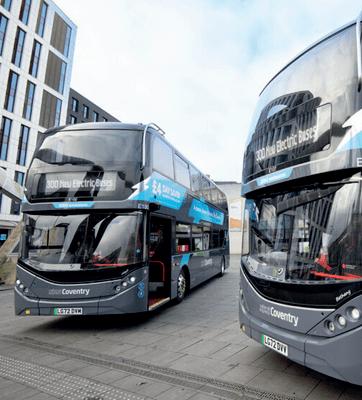
NEWS IN BRIEF
Coventry University is to play a key role in a new £15 million trial of self-driving technology on the city’s streets.
Hydrogen electric truck firm Tevva has completed a winter testing programme which saw its zero-emission 7.5t vehicle complete 350 miles on a single charge.
Nissan has confirmed plans to manufacturer an electric vehicle with a solid-state battery by 2028, with a pilot solid-state battery production plant up and running by 2025.
It is understood that the new model is due to go on sale in 2026, after a pick-up version of the Grenadier.

The design is set to be signed off shortly and the technical specification is already taking shape. Our exclusive image shows how we think it might look, taking plenty of cues from its rugged bigger brother.
At the launch of the Grenadier, Ineos boss Sir Jim Ratcliffe revealed more about the company’s
plans for expansion with an all-electric model.
“With the Grenadier itself, clearly its USP is the off-road bit. And I think that we’ll try to retain that theme through whatever range we finish up with,” said Ratcliffe. “I don’t know how much we’ve talked about the electric version of the Grenadier, but we’re well on with that project.
“It’ll be fully electric, with a range of 400 kilometres [249 miles]. It’ll be a bit smaller than the Grenadier, but it’ll look like a younger brother, I suppose.”
A new study from Juniper Research has found revenue from electric vehicle charging will exceed $300 billion globally by 2027.
Volvo Construction Equipment has invested around $7.8 million into battery pack production at its excavator plant in Changwon, South Korea.
7 EV NEWS
INEOS Automotive has started development of a new, slightly smaller, all-electric off-roader.
GHT SPARK
The meteoric rise
of myenergi
Recently ranked as the ninth fastest growing company in the UK, myenergi is spearheading the nation’s transition to sustainable living. With a range of EV charging and renewable energy products available, the company continues to grow at an impressive rate. But what is next for myenergi?


MYENERGI 8 INTERVIEW AN
BRI


9 MYENERGI INTERVIEW AN
Hi Tom. We last spoke to you when you were at Chargemaster. You’ve been at myenergi for almost a year now. How has it been so far? What attracted you to the company?
Two things really attracted me. Firstly, it’s opportunity to work in a broader product set. myenergi is a fantastic business that isn’t just an EV charging provider. Our first product was the eddi, the energy diverter, and we’ve got our Libby now home battery. We’ve got this amazing product range where we can really start to connect the home energy ecosystem and that for me is a massive draw. Being able to step outside just EV charging and think more broadly about how we’re going to decarbonise the rest of our lives.
Secondly, it was the brand. myenergi is a brand I’d admired for years, I’d really admired what Jordan (Brompton) had done with building the brand and maintaining it in this very honest, transparent and very credible way. There’s no better business than one that’s been formed by this genius engineer in Lee Sutton, our CEO, and a genius marketeer in Jordan, who’s our CMO. Those two as co-founders was just an unbeatable combination. In my time in personal communications and PR, trying to help people tell their story, I’ve seen so many businesses that have a fantastic engineering side but they have no ability to communicate it, and it’s so sad because they’ve got a great product. Here, you’ve got that genuine incredible mix of a really great product, really great, strong engineering skills behind it and the ability to help consumers understand it.
The rise of myenergi has been meteoric. What have been some of the biggest milestones for the company over the last twelve months?

You’re right, myenergi’s rise has been meteoric. We’ve seen annual growth in the business of not far off 200% a year as an average growth rate, which is just unheard of. It’s one of those great British success stories. We were recognised last year as being was the ninth fastest growing private company in the UK, which is a huge achievement. We’ve now shipped over 450,000 products and we’ve launched a new product in our ecosystem. We’ve got our new factory that’s just gone up next door. We have our manufacturing site over in Grimsby Town at the moment, which is about 4000 square foot and we’re moving into one that’s co-located here with our head office. It’s about 65,000 square foot and that’ll be huge for us and not just in terms of the capacity that it offers to the business to grow, but also bringing our team together in one site.
Talk us through all the different products myenergi offers...
Our first product was the eddi, the solar energy diverter, and what that allows you to do is divert surplus solar. If you’re generating solar energy and you want to send it somewhere, you can divert it to a useful place if you’re generating excess solar energy.
The eddi is a really key product for us and was the cornerstone the business as it was founded, The zappi, our EV charger, was the next logical step -

MYENERGI 10 INTERVIEW AN
In an exclusive interview with EV Powered, Tom Callow, Head of External Affairs for myenergi, shares his thoughts on the long-term goal of the company and the importance of solar in the UK’s green transition.
“MYENERGI’S RISE HAS BEEN METEORIC. WE’VE SEEN ANNUAL GROWTH IN THE BUSINESS OF NOT FAR OFF 200% A YEAR AS AN AVERAGE GROWTH RATE, WHICH IS JUST UNHEARD OF. IT’S ONE OF THOSE GREAT BRITISH SUCCESS STORIES.”
What else can we send this solar to? Electric cars have nice big batteries to shove load of electricity in. So if you’ve still got energy being generated that you’re not able to capture after that, well you can add on a home battery as well, because the great thing about that is it’s permanently connected. If you do drive to work in your electric car, for example, you’re not going to benefit from that home solar happening in the middle of the day, but t if you’ve got a grid connected battery that’s always there, always connected to your home, you can dump that excess solar in the battery when you’re at work and you come home and you can either use to charge electric car or run your home, for example, in in the evening.
We’ve also got our harvi, which is our energy harvester, which basically harvests energy off a cable. It’s a wireless current transformer that helps us monitor energy as well. Our business has IP around that current sensing technology, so we’re able to do it in a much cleverer way than a lot of other companies are in terms of seeing where your power is in your home, where the energy is being generated and where we can send it.
 Tom Callow, Head of External Affairs for myenergi
Tom Callow, Head of External Affairs for myenergi


11 MYENERGI INTERVIEW AN
How important is the role of solar in the overall growth of not just the electric vehicle industry, but in the sustainable living industry as well?
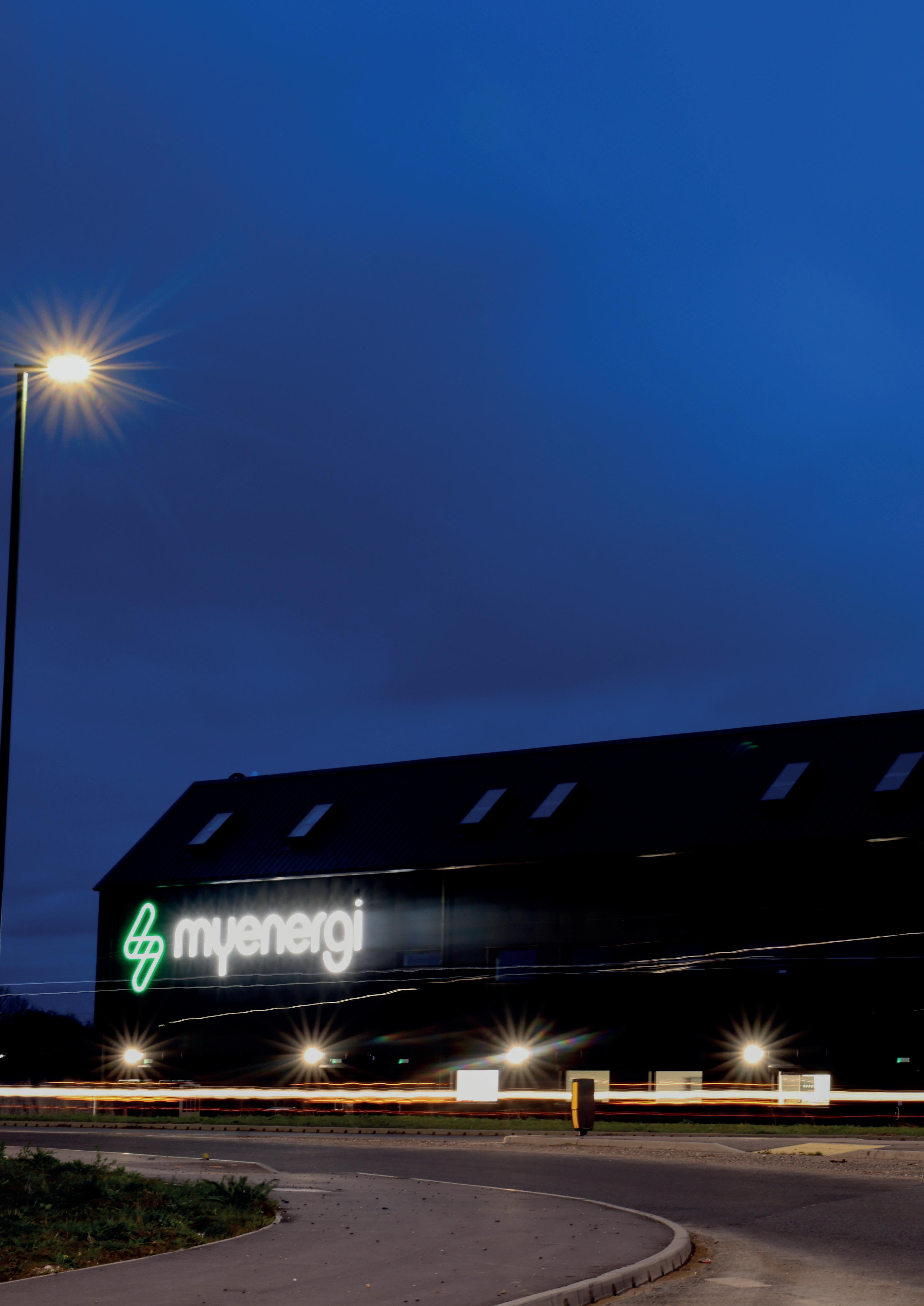
It’s not just solar but renewable energy generally. The zappi and the eddi products, for example, our product range can work with different forms of microgeneration as we call it. Microgenerations is your own self generation, typically solar. We can also power off hydro or wind and we do have customers that have their own hydroelectricity.
Solar is going through the roof at the moment in the UK.
We’ve seen domestic solar installations treble last year since 2021 and the same will probably happen this year. It’s really accelerating fast. Part of that is about costs coming down; more and more consumers are able to actually afford it. There are quite innovative financing models coming out now, so we’re seeing people being able to in-
stall solar at almost no upfront cost. We are still going to work on democratising it and making it more accessible.
The key thing about the energy system and renewables is that the ecosystem is quite harmonic. You’ve got a grid that basically needs to go, needs to decarbonise and frankly has done a great job of decarbonising. The energy system in the UK has decarbonised way faster than any other industry, but what you need with renewables is the ability to back them up when they’re quite peaky, because if the sun isn’t shining, winds not blowing, you need to be able to provide power. Things like batteries, energy storage at scale is key to that because you can step in and fill the gaps when solar or wind aren’t being able to perform. The systems have to work in harmony.
MYENERGI 12 INTERVIEW AN
SOLAR IS GOING THROUGH THE ROOF AT THE MOMENT IN THE UK. WE’VE SEEN DOMESTIC SOLAR INSTALLATIONS TREBLE LAST YEAR
SINCE 2021 AND THE SAME WILL PROBABLY HAPPEN THIS YEAR. IT’S REALLY ACCELERATING FAST.
What are the next steps for myenergi?
We’re all about pioneering a simple transition to renewable energy, and pioneering is an important word because we want to be at the forefront. Simple is a really important word also. We don’t want consumers to be baffled by the transition to renewable energy. We don’t want them to have to go and read an encyclopaedia of energy to understand as much as we do. We want consumers to have to be able to make this switch in a way that doesn’t confuse them.
In the short term, you’re going to continue to see us innovate. You’ll obviously see new and improved products over the years from us. We are also about services as well and actually we aren’t just a manufacturer; we provide services. We’re one of the only companies that isn’t what I would call a grid company participating in the grid trial events about providing that demand side response to customers. All of our products have what’s called frequency response inside, so we can do that interface with them where they reduce
their consumption and they can adjust rates of charge or rates of consumption etc, and we’ve had that from the get-go. We’ve had that in our products from day one. A lot of companies don’t have that yet and certainly haven’t had that from day one. We’ve already got that baked into people’s properties that we’re able to interface in that way. We’re already thinking and offering those sorts of services and we’re thinking about what’s next in terms of how we provide that to both consumers, but also provide it to the grid. What we want to see is a sort of a democratised system where companies like myenergi can provide those services to National Grid and others, so it’s not just the big boys that get to offer those services.
We should democratise and make sure that companies that are capable of offering this sort of technology and these services and benefits back to the grid are able to do so and it shouldn’t be monopolised among the big six energy suppliers.

13 MYENERGI INTERVIEW AN
VERGNE REIGNS SUPREME IN INDIA


DS Penske’s Jean-Eric Vergne produced an energy management masterclass to win the inaugural Greenko Hyderabad E-Prix in Round 4 of the ABB FIA Formula E World Championship.

Porsche’s Antonio Felix da Costa was elevated to the final spot of the podium in third after Sebastien Buemi was handed a late drive-through penalty for overusing the maximum power allowed.
At the start of the race, polesitter Mitch Evans led the field from Vergne, with Buemi slotting into third place, but Evans would take an ill-timed Attack Mode early in the race on lap 7, which would drop him a net third behind Buemi and Vergne. However, things would go from bad to worse for Jaguar just a few laps later, with Sam Bird crashing into the side of Evans and sending both cars out of the race on home turf for the team’s owner Tata Group. Bird was trying to pass the Nissan of Sacha Fenestraz for fourth place into the hairpin but ended up sliding into Evan’s car, pitching the Kiwi into a spin and with terminal damage into the car.
Both Fenestraz and Maximilian Guenther had nowhere to go and got caught out in the incident, although the two were able to continue without any damage.
The melee benefited a number of drivers, not least Cassidy, who now found himself third behind Buemi and Vergne.
Vergne wasted little time afterwards to pass Buemi for what would turn out to be the race-winning move, passing the Swiss driver going into the hairpin.
Buemi immediately armed the Attack Mode which was located on the outside of the same corner, which promoted Cassidy up to second and set-up a two-horse race for victory.
But before they could duel for the win, the safety car was deployed as Hughes crashed his McLaren and was left stranded on track.
At the restart, Rast went into the back of Dennis’ Andretti and immediately tumbled down the order with front wing damage, with Dennis also picking up a puncture on the incident and having to make an unscheduled pitstop for a fresh tyre.
It undid Dennis’ stunning recovery from 11th on the grid, with the Andretti driver having scythed his way to third, which would have been enough to take the championship lead from Pascal Wehrlein.
FORMULA E 14
DS Penske’s Jean-Eric Vergne produced an energy management masterclass to win the inaugural Greenko Hyderabad E-Prix in Round 4 of the ABB FIA Formula E World Championship.
FORMULA E
Instead, Wehrlein finished fourth behind teammate da Costa after an impressive drive of his own from 15th place at the end of the opening lap.
Sergio Sette Camara finished a strong fifth for NIO 333, while Oliver Rowland bagged a strong haul of points for Mahindra in sixth place.
Rowland even attempted an ambitious move over Buemi for third place on the outside of the hairpin in the closing stages of the race, but he ran wide and instead lost momentum that left him sixth at the finish.
Norman Nato scored his first points on the year in seventh, with Stoffel Vandoorne (DS Penske), Andre Lotterer and Edoardo Mortara (Maserati MSG) completing the points scorers.
SEASON
The result means Porsche’s Pascal Werhlein extends his lead at the top of the Drivers’ Standings, with an 18-point gap over Avalanche Andretti’s Jake Dennis who finished outside of the points for the first time this season.
The victory for Vergne lifts the Frenchman up into third in the standings, level on points with Envision’s Seb Buemi.
Speaking after his first victory of the season, Jean-Eric Vergne said: “I am obviously very happy with this victory! It’s great for the team to get back to the top after three tough races, and to come back to everyone with a win after working so hard on our understanding of the car. Clearly, we have made good progress. We have to keep up this momentum but, to tell you the truth, I’m quite confident because I think we still have a lot of room for improvement. It’s up to us to keep working hard to get more results like this!”

Sam Bird commented on his incident which retired both Jaguar TCS Racing cars after the race: “I’m incredibly sorry to all of the team, Mitch and the other driver’s races that I ruined today. We have a really strong car and I made a mistake which cost everybody. I know how hard everyone has worked and I hope I can make it up to everyone in Cape Town.”
The ABB FIA Formula E World Championship heads to Cape Town on 25th February, with this issue of the EV Powered Magazine going to press before that race. The next edition of the magazine will therefore feature a report of Round 6 of the Championship in Sao Paulo, which takes place on March 25th.



15
9 26 PTS POS DRIVER TEAM RD1 RD2 RD3 PTS Pascal Wehrlein Jean-Éric Vergne Jake Dennis TAG Heuer Porsche Formula E Team Avalanche Andretti Formula E 18 P2 25 P1 25 P1 DS Penske RD3 12 P4 80 31 62 1 3 2 0 P12 6 P7 0 P16 25 P1 26 P1 18 P2 18 P2 0 P16
T DHE ESERT WAITS
AExtreme E makes its long-awaited return this month, with Season3 kicking off with the traditional Desert X-Prix in the NEOM region of Saudi Arabia.



The stage is set for another year of thrilling racing and nail-biting drama, with new teams and new races to look forward to. Ten rounds of racing will take place across three different continents with some of the most challenging terrains on the planet.

After the curtain raiser in Saudi Arabia, Extreme E will descend on Scotland for the first time, with a new circuit located in the village of Sanquhar for the ‘Hydro X-Prix’. A double header in Sardinia will follow for the ‘Island X-Prix’ before two rounds of racing in either the Amazon rainforest or the USA, with the exact location to be confirmed. The season finale will the take place in Antofagasta, Chile for the Copper X-Prix.
The opening round of the season will take place on the shores of the Red Sea close to the location of the 2022 NEOM Beach Games, which hosted over 300 athletes from 25 countries.
Teams will once again face a mostly sandy terrain, though a very different challenge and location to the deserts of the series’ past two visits to Saudi Arabia.
Many of the drivers will have experienced a shoreline course before, at the Ocean X Prix in Senegal in 2021, but all will have to be at the top of their game to meet the unique demands of this terrain.
EXTREME E 16
EXTREME E
FRESH FACES
A new team will be taking to the grid this year, with the DJ and electronic artist Carl Cox entering his own team, ‘Carl Cox Motorsport Extreme E’.
The eponymous team marks Carl’s first venture into electric racing, however he is no stranger to the world of motorsport having launched Carl Cox Motorsport officially in 2013 as a multi discipline outlet for vehicles with two, three and four wheels.
Cox, Founder and Team Principal of Carl Cox Racing, commented: “I’m here to make a difference. To have the opportunity to be part of something so dynamic on four wheels is a dream come true. Racing, like music, is in my blood and I’m going to bring my passion and energy into this series and build something special.
“Participating in electric racing is new to me but I’m a fast learner and will bring my hard earned know how and experience into the mix at Extreme E. Carl Cox Motorsport is here to take on all comers and we are going to jump straight in. We are in it to win it.”
Carl Cox will join a host of legendary motorsport names including McLaren, Lewis Hamilton (X44 Vida Carbon Racing), Nico Rosberg (Rosberg X Racing) Jenson Button (JBXE), and Carlos Sainz Snr. (ACCIONA | SAINZ XE Team), all of which will be looking to claim the Extreme E World Championship crown.
FRONT RUNNERS
Extreme E has seen two different winners in its first two campaigns, with Rosberg X Racing claiming the inaugural title in 2021, before X44 Vida Carbon Racing claimed the championship in the final race of the season at the end of last year. The results just go to prove that the Extreme E is unpredictable and any team can win on any day, thanks to its world class driving talent and unforgiving conditions.
The previous winners of Rosberg X Racing and X44 may be the favourites heading into Season 3, but the likes of Hummer EV Chip Ganassi Racing and McLaren will have a point to prove this year.
With ten teams and twenty drivers set to battle it out across the toughest race tracks on the planet, who will came out on top?
MOTORSPORT WITH A PURPOSE
NEOM will start the global voyage of Season 3, highlighting the impact of climate change and human interference in one of the most remarkable and remote locations in the world, whilst promoting the adoption of electric vehicles in the fight to help preserve the environment and protect the planet.
The region is the centrepiece of Saudi Arabia’s Vision 2030 plan to grow and diversify the Saudi economy and position the country as a leader in global sustainable development.
The Desert X Prix marks Extreme E’s third event in the region, pursuing the mutual goal of combining sustainability with global sporting events.



Alejandro Agag, CEO and Founder of Extreme E, said: “Using our sport for purpose platform, Extreme E truly stepped things up another level last year and delivered some of the best racing action in the series so far. Now, we are ready to go and do it all again, with more ambition than ever before.
“Entering our third season, we are proud to welcome legendary DJ Carl Cox to the party and are excited to see his team, Carl Cox Racing, take on the rest of our star-studded grid. We have such a strong field in Extreme E for 2023, from our championship-winning outfits led by Nico Rosberg and Lewis Hamilton, respectively, to strong challenger line-ups in the likes of NEOM McLaren Extreme E, Veloce Racing, and ABT CUPRA XE preparing to push competition boundaries.
17
SPARKING JOY?
Chief Partnerships Officer at Leasing.com, Paul Harrison, says new car consumer demand contradicts the recent wave of negative publicity surrounding electric vehicles.

Chief Partnerships Officer at Leasing.com, Paul Harrison, says new car consumer demand contradicts the recent wave of negative publicity surrounding electric vehicles. For a vehicle that is almost silent in operation, EVs are making a considerable amount of noise. The recent debate in the press around EV popularity, range anxiety, infrastructure shortages and the looming 2030 ban on new petrol and diesel cars has generated some uncertainty. Or so it seems. Certainly there has been a wave of print and broadcast media coverage in recent months that seem to suggest that some individuals and businesses are falling out of love with electric vehicles, before many motorists have had the chance to enjoy the romance.
A recent article in The Sun, for example, with a screaming headline of ‘Sparks Gone’, seemed to suggest that EV drivers were abandoning their vehicles ‘in their droves’ and racing back to petrol. Photographs appeared across various digital platforms over the Christmas and New Year Bank Holiday periods of frustrated drivers queuing for hours for their turn to charge. And The Sunday Times also ran an article recently that similarly led with the message that Britain’s EV revolution ‘risks coming unplugged’.

UNPICKING THE FACTS
Some of these stories can be easily countered and unpicked. A recent study from Zap-map, for example, showed that 98% of EV drivers would not switch back to electric, which instantly counters The Sun’s hyperbole regarding almost universal dissatisfaction within the EV driver fraternity. Some stories are more challenging. Range anxiety in relation to charging infrastructure appears more rooted in fact, but even then the picture is mixed, and it depends on who you ask.
Ask Liberty Charge, for example, and it appears that the UK is a long-way short of meeting its infrastructure targets, and if it continues at its current pace, those targets will not be reached. The picture, however, is a complicated one, since all elements of ‘infrastructure’ need to be considered, including both on-street and offstreet charging. If one considers that at least 11 million households have no access to off-street EV charging, then that is bound to have an impact on EV adoption. Electric, like all vehicle fuel types, isn’t necessarily right for everyone right now. Local Authorities also appear to be slow to react – some admitting to having no future EV charging strategy – and that has to be a concern. The Government may be making investment available, but access to that investment depends on having a coherent strategy in place.
Ask Swarco Smart Charging and a similar picture emerges, and the need for greater urgency is clear. Its pioneering work around the creation of charging ‘hubs’ however, to support the charging

EV REPORT 18
of higher volumes of EVs, and to a higher power are proving especially popular both with taxis and private vehicles and developed with the full support of the local authorities. ‘Traditional’ petrol forecourts are adopting a larger number of charging points, and in some cases, have converted to be fully electric. This trend will only continue, as is the trend for the increasing use of complementary technologies including solar car ports and energy storage solutions.

EMERGING INFRASTRUCTURE
New ‘models’ are also emerging and new players – businesses that build, own and operate, but whose models are still dependent on reliable thirdparty technology, maintenance and services. Such is the interest in EVs, that many fossil-fuel companies are either acquiring or launching their own solutions as are many in the construction and utilities sectors. Partly this is being driven, by the need for self-preservation, but it has the effect of keeping the market keen and driving further innovation. Neither business is complacent. Both acknowledge the scale of the challenge. New Automotive’s ‘On the Road to 2030’ report, and in particular its important recommendation that the uptake of EVs must not be slowed ‘in order for infrastructure to catch up’ achieves wide support. But its claim that the industry is ‘on track’ to deliver the Government’s ambition of 300,000 public EV charge points by 2030 is being challenged. Zap-Map figures show there were 8,886 public electric vehicle charge points installed in 2022. While this represents a 30%-35% annual increase, it is also less than a third of the 27,000 public chargers a year that the Competition and Markets Authority (CMA) estimate would have to be installed each year to meet future demand.
So perhaps despite, rather than because of, the future roll-out of EV infrastructure, and media headlines, the popularity for EVs remains high, and our data does not point to any dampening down of enthusiasm. Leasing. com statistics show that leasing demand for battery electric vehicles (BEVs) outperformed the overall new BEV market last year, even when factoring in consumers adjusting their vehicle preferences following the cost-of-living crisis.
CHANGING CONSUMER BEHAVIOURS
End of year data shows a step change in consumer behaviour when it comes to choosing a family car. In a year that saw fuel shortages, fuel price hikes, supply chain issues and a country wrestling with the cost-of-living crisis, the automotive market had its fair share of challenges.
New vehicle registrations for 2022 were down 2% on 2021 to 1.61 million units. Wider macro-economic and supply chain issues continued to affect availability and dictate new car demand with the Nissan
Qashqai, Kia Sportage and Hyundai Tucson outperforming other established brands to become the stars of the 2022 leasing market.
One constant theme of 2022, notwithstanding the challenges, was the continued surge in demand for electric vehicles. All electric vehicles (plugin, hybrid and battery) accounted for 35% of total demand seen on Leasing.com, up 18% on the demand seen in 2021. Data from the Society of Motor Manufacturers and Traders (SMMT) shows BEVs accounted for 17% of new car sales last year, whereas BEV demand on Leasing.com outperformed the market accounting for 19% of total sales enquiries – an increase of 15% on 2021 BEV demand.
Perhaps not surprisingly, demand for diesel continued to decline last year with diesel-engined vehicles accounting for 11% of Leasing.com sales enquiries, down from a market share of 17% in 2021.
LATEST STATISTICS
Looking at our most recent data, exclusively for EV Powered, sales enquiries for BEV and hybrid vehicles via Leasng.com more than doubled in January 2023 compared to December 2022.
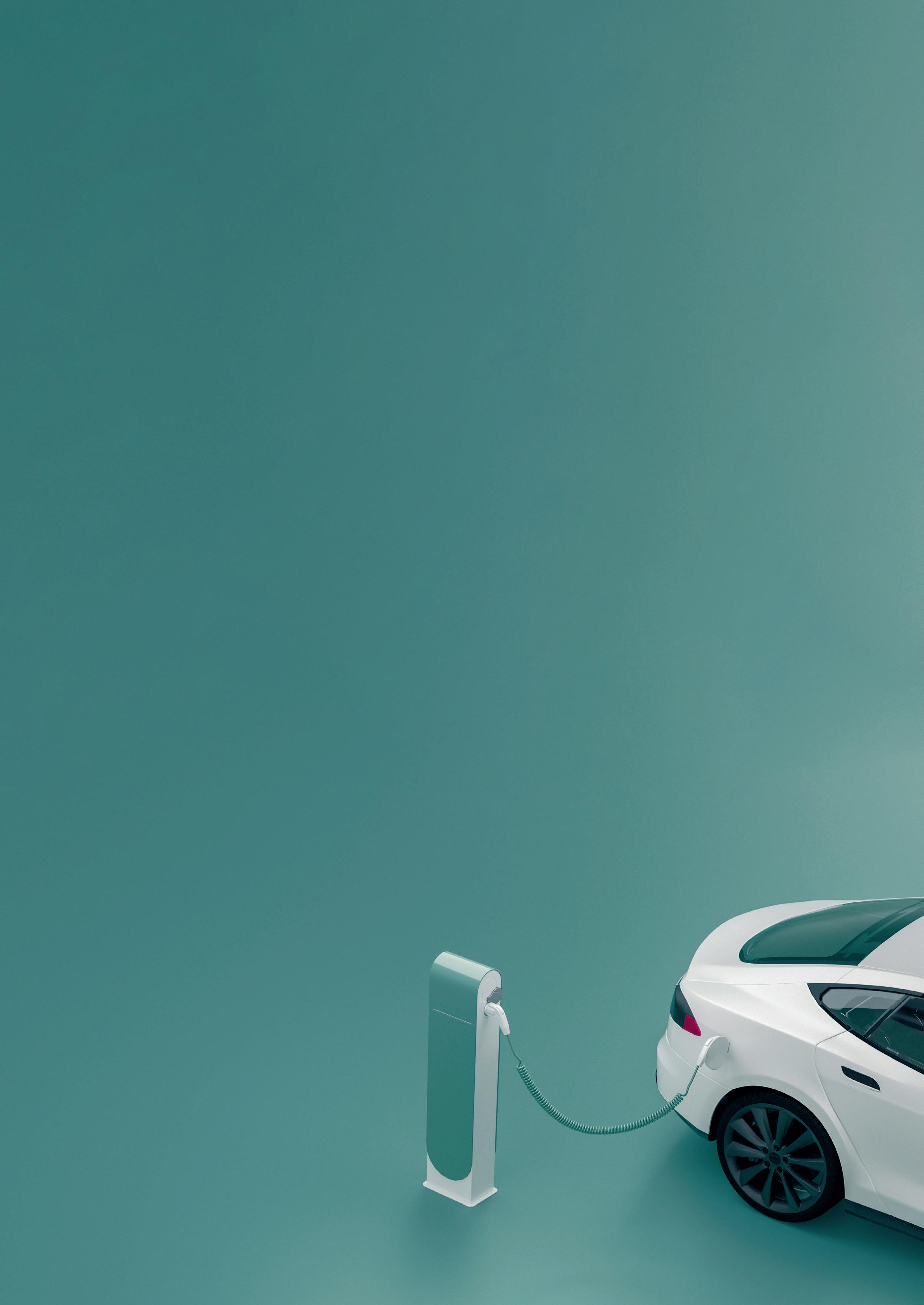
BEV enquiries rose by 111% whereas enquiries into hybrid models rose by 79%. It is interesting to note that this was just at the point that negative publicity was at its height, suggesting that individuals and businesses were not swayed the media headlines at the time.
Enquiries on the most popular of BEV, the Tesla Model 3, also rose significantly following Tesla’s publicized price reductions, and with the number of brand new BEVs being launched ever-increasing there really is something for everyone to choose from. Despite the impact of the cost-ofliving crisis on household budgets, demand for electric vehicles remain buyant and we are expecting EVs to account for a record 30% of the total vehicle demand seen on our website this year. Leasing remains the most cost-effective way for motorists to access the latest EV models and technology.
PAUL HARRISON Chief Partnerships Officer at Leasing.com

19 EV REPORT
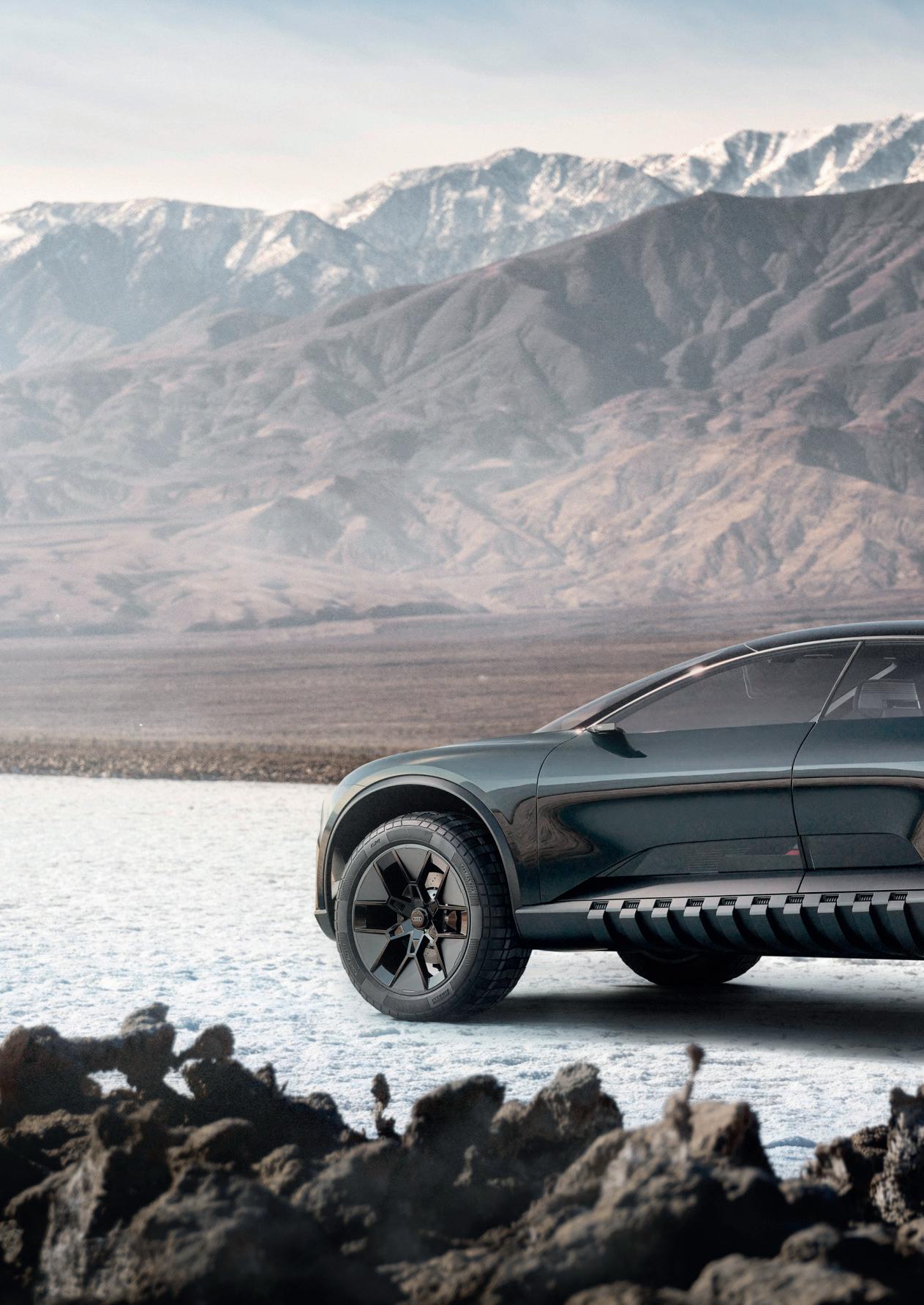

S


S
Following on from the Audi skysphere roadster in 2021, and both the Audi grandsphere saloon and the Audi urbansphere space concept in April 2022, the Audi activesphere concept marks the culmination of sphere concept vehicles and takes the shape of a fourdoor crossover coupé.
EXTERIOR DESIGN
Standing at 4.98 meters long, 2.07 meters wide, and 1.60 meters high, the activesphere will have a large wheelbase of 2.97 meters, providing maximum legroom for passengers.
The body will consist of short front and rear overhangs which will combine to give the impression of a compact design, despite it being one of the longest cars produced by Audi. The sleek, monolithic architecture gives a smooth, flowing transition from the front to the rear of the vehicle, with dramatic features such as the wheel arches and underride guard highlighting the vehicles off-road capabilities.
With large, 22-inch wheels and its impressive ground clearance will enable the activesphere to cope with rugged terrain, whilst the roof arch retains the desirable sports car aesthetic. The wheels feature movable segments: when used off-road, they open for optimum ventilation, and they close on-road for optimum aerodynamics. The camera mirrors on the two front doors are also designed specifically to minimize drag.
The Audi activesphere’s ground clearance is also variable; ideal for off-road use, it can be increased by 40 millimetres from the basic height of 208 millimetres, or lowered by the same amount when driving on-road. This benefits both the centre of gravity and aerodynamics when driving fast. The approach angle of the Audi activesphere – relevant for offroad drives - is 18.9 degrees, the departure angle 28.1 degrees.

The variable ground clearance is a nod to the Audi ‘allroads’ of the 2000’s, and the activesphere marks the first time that a car

A U D I
with a Sportback hatchback incorporates the design elements and technical equipment of an allroad. For this reason, Audi calls the new body variant “active Sportback” in contrast to the allroad. Another new variation of the allroad theme – the Audi activesphere concept features dark, high-gloss paint finishes in Arctic Teal on the front and rear as well as underneath the doors in the side area, plus matte surfaces that deliberately contrast the floor assembly and cabin.
Glass surfaces also occupy a large portion of the vehicles body, with the front end of the activesphere featuring the brand face, the Singleframe, designed as a “transparent glazing to afford passengers an unobstructed view through the large frunk of the road in front of the vehicle.”
There is also a glass surface on the lower door area, as well as on the curved tailgate which has been designed to let as much natural light inside the car as possible.
The Audi activesphere concept is a “master of metamorphosis,” according to the manufacturer. This means the

AUDI ACTIVESPHERE 22
THE AUDI ACTIVESPHERE CONCEPT IS A “MASTER OF METAMORPHOSIS,” ACCORDING TO THE MANUFACTURER.
THIS MEANS THE CONCEPT IS A “CROSSOVER OF BOUNDARIES.”
concept is a “crossover of boundaries,” with the rear of the vehicle reflecting “the active lifestyle of its customers and makes it possible to transport even bulky sports gear – without sacrificing the elegance and sportiness of the Sportback silhouette.”


If required, the transparent rear window slides are almost flush with the roof of the Audi activesphere. At the same time, the lower, vertical segment of the rear folds horizontally – this opens up a cargo bed called the ‘active back’ that features brackets for e-bikes, for example, all but transforming the activesphere in the very first Audi pick-up.
The lateral surfaces of the rear, the C-pillars, remain in position to maintain the activesphere’s silhouette, whilst a motorized bulkhead deploys from behind the rear seats in order to isolate the cabin from the elements. A ski rack is integrated in the center of the roof structure. Completely flush in nominal position and practically invisibly in the roof arch, it extends if required, so that skis can be safely attached and transported.
23 AUDI ACTIVESPHERE
INTERIOR DESIGN
The key theme between all the different ‘sphere’ concepts is that the interior is the priority for these vehicles. In the words of Audi: “Kilowatts and mph or lateral acceleration are no longer at the top of the design specifications for this new generation of cars. Instead, the starting point is the interior, the occupants’ living and experience sphere whilst travelling. Their needs and desires shape the space, the architecture, and the functions.”
The activesphere is the “epitome of clarity and tidiness,” Audi states, with a stripped back interior that is dominated by full-length centre console. Resting on the centre console, the upper end of the seat shell’s inner side is shaped horizontally as an armrest. The designers imagined the seat, back, and shoulder surfaces as three separate, circumferential shells to give the impression of a lounge chair.
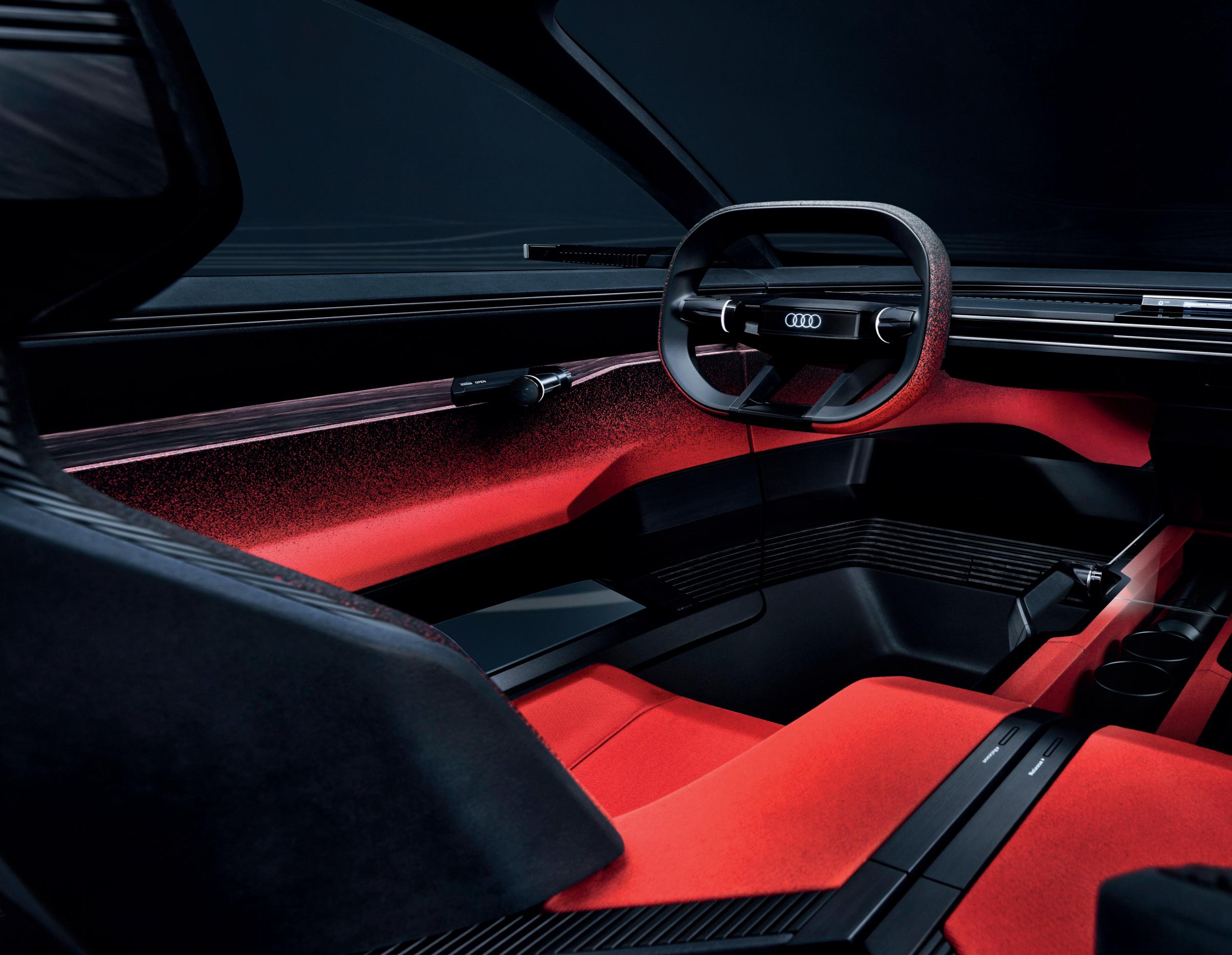
When the Audi activesphere concept is driving in autonomous mode, the dashboard, steering wheel, and pedals disappear as a wide space opens in front of the driver,
which extends to the front end of the activesphere – and beyond. For a clear field of vision, the fully glazed Singleframe gives passengers an unobstructed view of the road in front. The dashboard itself works like a large soundbar as well as a smart, full-width air vent in both the deployed and stowed position. If the driver wants to take over the wheel, the dashboard, along with the steering wheel, swivels out from its flush position below the windshield – each driver can adjust the ideal ergonomic position individually.
The MMI touchless controls in the doors are always accessible to the eye and the hand, for example, to control windows and seat adjustments. The architecture and sense of space in the Audi activesphere are largely determined by the high, full-length centre console.
Additionally, there is a console in the roof, directly above the centre console and reflecting its dimensions, where the four AR headsets for the mixed reality system are kept within easy reach for all passengers.

AUDI ACTIVESPHERE 24
“EPITOME
A U D I
PREMIUM PLATFORM ELECTRIC
ThDue to its dimensions and performance level, the Audi activesphere concept lends itself to the use of Audi’s most innovative electric drive system: the Premium Platform Electric, or PPE for short.

Like the related Audi grandsphere and Audi urbansphere concept cars, the activesphere concept draws on this modular system for series production. It is being developed under Audi’s leadership together with Porsche AG – the first Audi production vehicles based on PPE will be presented, one after the other, before the end of 2023. The PPE is designed exclusively for battery-electric drive systems and can therefore take full advantage of all the benefits of this technology – for the betterment of the car’s driving characteristics, economy, and package options. As a result, Audi can effectively expand the range of electric vehicles in its portfolio via the high-volume B- and C-segments. In addition, economies of scale will allow luxury-class technology and various model versions to be incorporated into a wide-ranging lineup of models unrivalled in the premium market.
The PPE is the first platform designed to accommodate a range of high-volume automobiles – including SUVs and CUVs with high ground clearance. This also includes cars with a flat silhouette that are part of Audi’s core product range, such as the Audi A6 series, whose external dimensions and wheelbase are almost identical to the Audi activesphere concept.
The key element of the future PPE fleet is a battery module between the axles; in the Audi activesphere concept, it holds around 100kWh of energy. Using the entire car width between the axles makes it possible to achieve a relatively flat layout for the battery.

Electric motors on the front and rear axles of the all-wheel drive Audi activesphere concept together deliver a total output of 325kW and a system torque of 720Nm of torque. The front and rear wheels are connected via a five-link axle. The concept car features Audi adaptive air suspension with adaptive dampers.

25 AUDI ACTIVESPHERE
THE ACTIVESPHERE IS THE “EPITOME OF CLARITY AND TIDINESS,” AUDI STATES.


A U D I
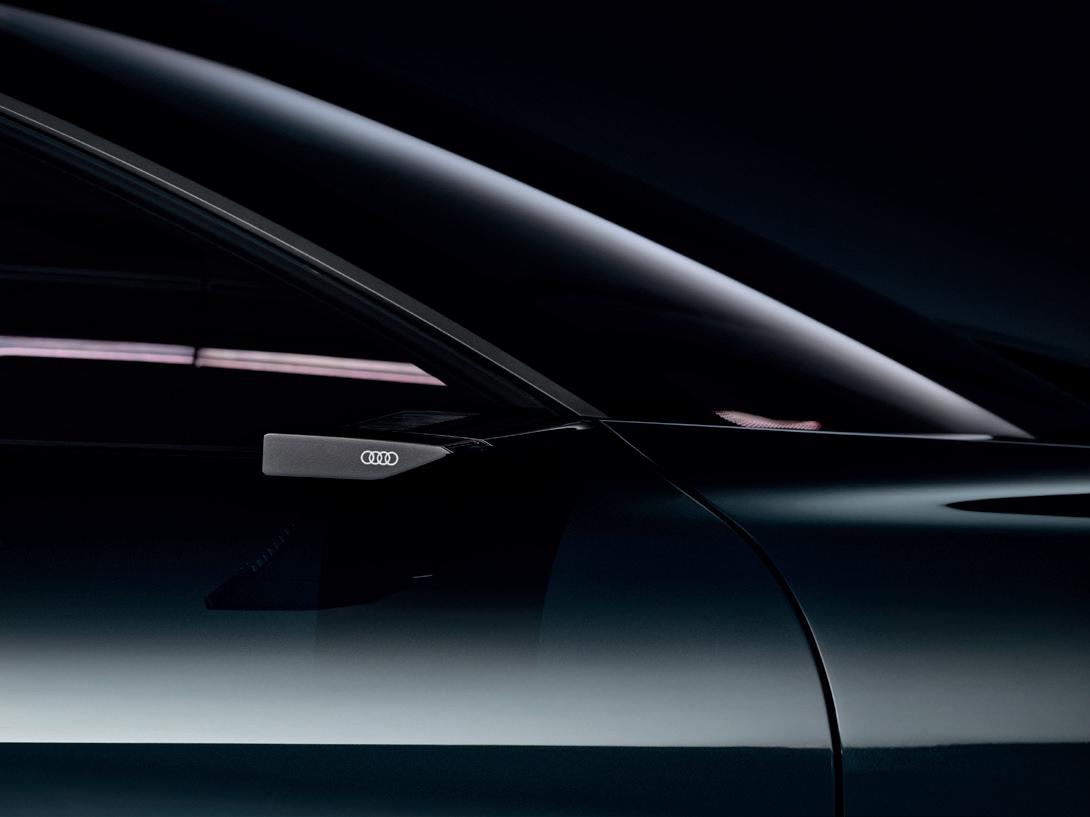


TOP TEN
BEST-SELLING ELECTRIC VEHICLES OF 2022
In another booming year for the electric vehicle industry, data from the Society of Motor Manufacturers and Traders (SMMT) has revealed the top ten best-selling EVs of 2022.
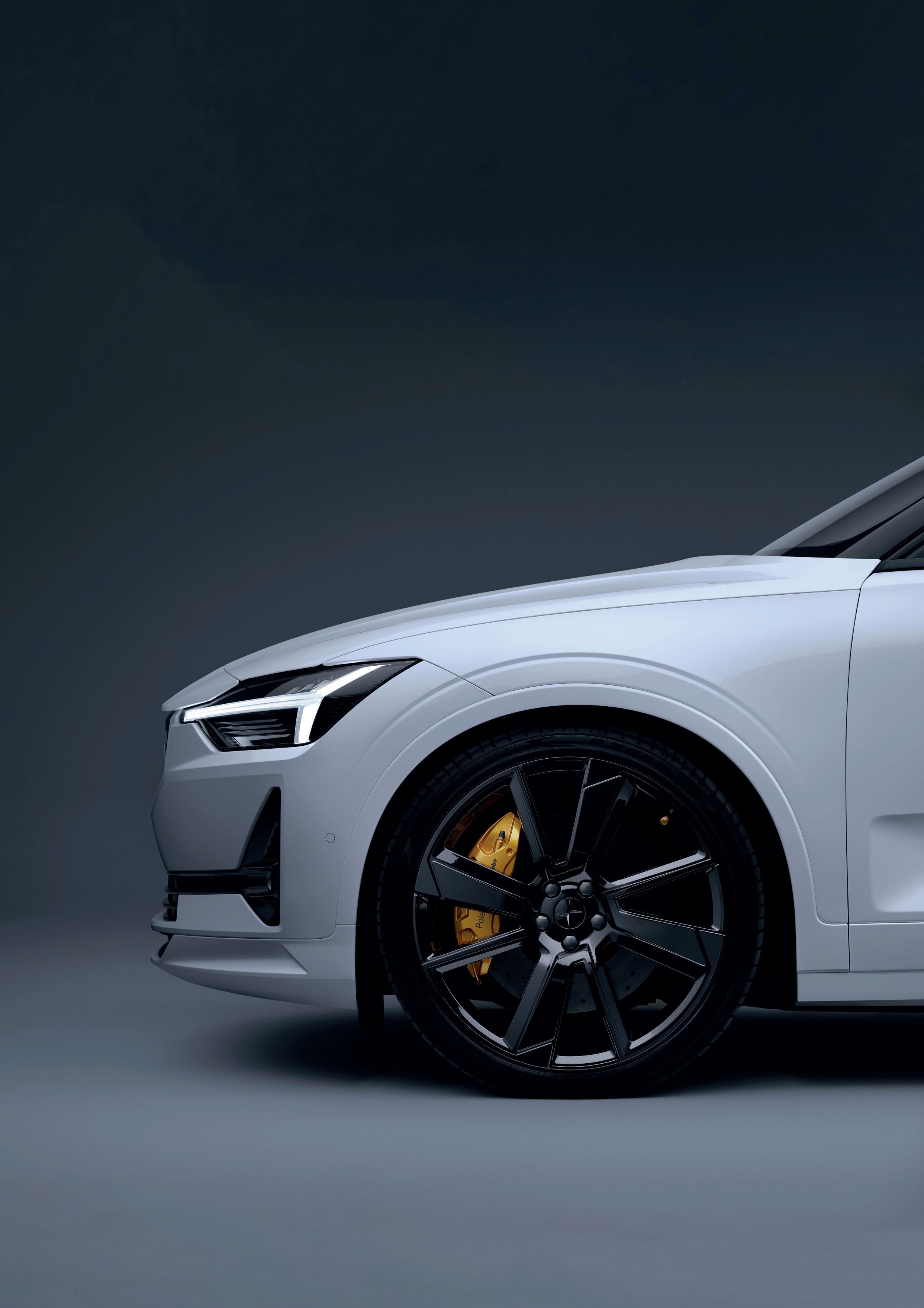
TOP TEN 28
TESLA MODEL Y
35,551



Unsurprisingly, Tesla dominates this list and the California-based brands fully-electric SUV takes the top spot, with 35,551 units being sold in 2022. It’s hardly surprising to learn that the Model Y is the best-selling EV in the UK, considering the popularity of the Tesla brand and the growth of the SUV segment in recent years.
For such a premium product, the Tesla Model Y is competitively priced in comparison to other electric SUVs, with prices starting from £44,990. It’s value for money, too, considering you’ll get a range of 283 miles and a performance package that consists of 0-60mph in 6.6 seconds. It’s easy to see why the Model Y was the best-selling electric vehicle of 2022.


TESLA MODEL 3
19,071
The best-selling electric vehicle of 2021 has been dethroned by its big brother, with the Tesla Model 3 having to settle for second place on this list. Of course, with over 25,000 people buying the Model 3 in 2021, this number was always likely to fall down slightly this year, particularly with the release of the newer Model Y.
Whilst the majority of the cars on this list will be priced in the millions, the Porsche Taycan Turbo S is moderately priced in comparison, with prices starting from £142,000. It’s still a hefty sum of money, but for that, you will get a


beautifully designed car that tops out at 162mph and offering 751 horsepower with launch control and 1,050NM torque. Despite these ridiculous numbers, the Taycan also offers a degree of practicality, with a range of up to 291 miles.
Despite being one of the most popular electric vehicles for a number of years, the Tesla Model 3 still offers an impressive amount of performance, with a 0-60mph time of just three seconds, and Long Range models boasting 374 miles off a single charge. Even with a growing list of models to compete with, I suspect the Tesla Model 3 will still be on this list next year.
Scan this QR code to watch a full, in-depth review on EV Powered’s YouTube channel
KIA E-NIRO
11,197


Kia brings an end to Tesla’s dominance on this list, with its ever-popular e-Niro coming in third, with 11,197 units sold in 2022. The vehicle may have only been on sale for three years, but its relatively affordable price mixed with a range of 230 miles and decent performance package means it still remains one of the most popular electric vehicles around.

VW ID.3 9,832
Even though the e-Niro has now been shelved to make way for the new Kia Niro EV and the brands flagship EV6, the e-Niro will go down as one of the most popular and renowned electric vehicles of recent times.


The Volkswagen ID.3 continues the theme of old stalwarts outshining the newer models. Despite Volkswagen accelerating its EV efforts with the release of the ID.4 GTX model and the ultra-funky ID.BUZZ, it is the manufacturer’s signature ID.3 that comes in at fourth on this list.
Whilst the majority of the cars on this list will be priced in the millions, the Porsche Taycan Turbo S is moderately priced in comparison, with prices starting from £142,000. It’s still a hefty sum of money, but for that, you will get a



beautifully designed car that tops out at 162mph and offering 751 horsepower with launch control and 1,050NM torque. Despite these ridiculous numbers, the Taycan also offers a degree of practicality, with a range of up to 291 miles.
Worldwide, the Volkswagen ID.4 was the brands most popular EV with 170,000 units sold, but in the UK, the ID.3 proved to be the most popular, outselling other models from the Group’s portfolio, such as the Škoda Enyaq iV and the Cupra Born.

NISSAN LEAF
9,178
Twelve years on from its original release and the Nissan Leaf is still going strong. The Japanese brands first electric vehicle makes it into the top five of this list with 9,178 units sold in the UK alone.
For many, the Nissan Leaf is associated with the ‘early adopter’ era of the electric vehicle industry, where EVs had a range of about 12 miles
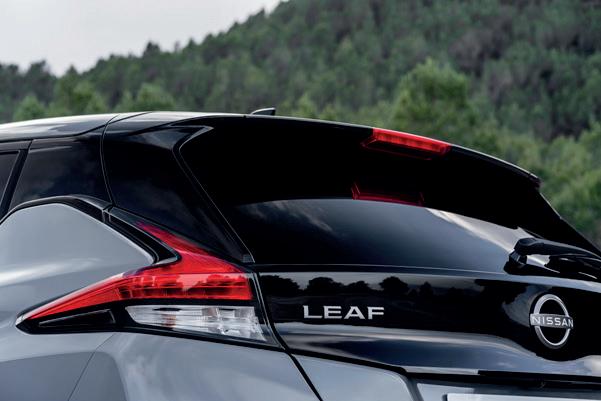
MINI ELECTRIC
and took 3-5 business days to recharge (or so many people thought, anyway). In this day in age, however, the Nissan Leaf offers an attractive and affordable package of 239 miles of range, 217PS and 340Nm of torque with a 0-62mph acceleration time of 6.9 seconds, all for the price of £36,445.

7,425


In sixth place on this list is the MINI Electric which also holds the title of being the best-selling British-built car of 2022. It is also the UK’s bestselling car from the BMW Group, which is impressive considering the list of models it is competing with, such as the BMW i4.


Whilst the majority of the cars on this list will be priced in the millions, the Porsche Taycan Turbo S is moderately priced in comparison, with prices starting from £142,000. It’s still a hefty sum of money, but for that, you will get a




beautifully designed car that tops out at 162mph and offering 751 horsepower with launch control and 1,050NM torque. Despite these ridiculous numbers, the Taycan also offers a degree of practicality, with a range of up to 291 miles.
The small, electric hatchback is the smallest car on this list but despite its diminutive frame, it offers an incredibly fun driving experience with 270 NM torque and 184hp. All of that does come at a cost to the range, unfortunately, with only 145 miles available from a single charge.
Scan this QR code to watch a full, indepth review on EV Powered’s YouTube channel
Scan this QR code to watch a full, in-depth review on EV Powered’s YouTube channel
POLESTAR 2
7,345



This year will be a significant milestone for Polestar as the Swedish manufacturer prepares to launch its next generation of electric vehicles, starting with the Polestar 3 SUV. The manufacturer will be hoping the new models are as popular as its existing Polestar 2 model, which was the seventh best-selling vehicle in the UK for 2022, with 7,345 models sold.


MG 5 7,030
The Polestar 2 is a new entry for this list, which highlights the growth of the Polestar brand. With a number of new models scheduled for release this year, you can expect to see Polestar appearing on this list again next year.
MG is enjoying its transition over to electric vehicles, with the MG4 EV being regarded as one of the best electric vehicles on the market, thanks to an affordable price and a level of performance that can compete with some of the more premium options around. However, it is the brands electric estate, the MG 5, that makes it onto this list.

Whilst the majority of the cars on this list will be priced in the millions, the Porsche Taycan Turbo S is moderately priced in comparison, with prices starting from £142,000. It’s still a hefty sum of money, but for that, you will get a



beautifully designed car that tops out at 162mph and offering 751 horsepower with launch control and 1,050NM torque. Despite these ridiculous numbers, the Taycan also offers a degree of practicality, with a range of up to 291 miles.
The MG 5 has earned rave reviews since its release, and considering the first models were delivered in September, MG only needed three months to sell over 7,000 units. With a range of up to 250 miles and 1367 litres of boot capacity, the MG 5 is one of the most practical electric vehicles on the market today.
 Scan this QR code to watch a full, indepth review on EV Powered’s YouTube channel
Scan this QR code to watch a full, indepth review on EV Powered’s YouTube channel
6,699 BMW i4
The BMW i4 is one of the most highly rated electric vehicles of last year, with the manufacturer’s gran coupe picking up a number of awards following its release. With prices starting from £56,185, that premium price tag wasn’t enough to put off the 6,699 customers that managed to get their hands on one.

AUDI Q4 E-TRON
As one of the first models of the new generation of BMW EVs, the i4 combines practicality with frightening performance, with 0-60mph time of up to 3.9 seconds and a range of up to 365 miles. It also offers a stunning interior with one of the most hi-tec infotainment systems around, with a curved display which can be operated with either gesture control or voice control.
6,594




Last on this list is the Audi Q4 e-tron with 6,594 units sold in 2022. We reviewed the QR e-tron at the beginning of 2022 and it’s easy to see why it was one of the most popular electric vehicles from last year. With a classy design, stunning interior and a reasonable(ish) price of £44,975 makes it one of the most attractive options within the burgeoning EV-SUV segment.


Whilst the majority of the cars on this list will be priced in the millions, the Porsche Taycan Turbo S is moderately priced in comparison, with prices starting from £142,000. It’s still a hefty sum of money, but for that, you will get a


You can watch our full, in-depth driving review of the Audi Q4 e-tron by scanning the QR code, and be sure to do that for all the other cars on this list, too!

beautifully designed car that tops out at 162mph and offering 751 horsepower with launch control and 1,050NM torque. Despite these ridiculous numbers, the Taycan also offers a degree of practicality, with a range of up to 291 miles.

Scan this QR code to watch a full, in-depth review on EV Powered’s YouTube channel
The UK is now in a position where drivers have the choice of several trusted, customer-focused and heavily-funded charging networks who are each deploying these large numbers of rapid charge points on motorways, A roads, retail parks and on residential streets, from the tip of Cornwall up to the Scottish Highlands.
IT’S A NUMBERSGAME

EV news in the first couple of months of 2023 has been dominated by criticism of the numbers of public charge points in the UK, especially the number installed in 2022 versus the growth in vehicle sales.
Whilst last year’s charge point deployment was affected by the supply chain delays suffered globally, I want to assure drivers that mass deployment of the public EV charging infrastructure continues to move forward, and now at greater pace than ever.
This year the country will see a mass deployment of literally thousands of new public chargepoints located at reliable hubs across the country. At Osprey alone, we installed in two weeks in January more chargers than we installed in the first two months of 2022. Our network will more than double in size in the next 12 months.

The UK is now in a position where drivers have the choice of several trusted, customer-focused and heavily-funded charging networks who are each deploying these large numbers of rapid charge points on motorways, A roads, retail parks and on residential streets, from the tip of Cornwall up to the Scottish Highlands.
Challenges do remain. Charge point operators are working collaboratively with the government to remove barriers and secure permitted development rights that would help reduce delays to currently complex and sometimes inconsistent legal processes involved in installing public charging.

This is particularly important for the installation of large hubs, where a substation and therefore a separate lease for this electrical infrastructure is required with the DNO. Osprey is (at the time of writing) developing 38 new high-power charging hubs on major transport routes, with multiple super-fast chargers in each location.
Finally, a note on measurement. The UK’s public charging needs will be met by a whole ecosystem of varying speeds, locations and types of service. Simplistic measurements of charging provision such as “public chargers per vehicle” or “public chargers per 100 people” miss crucial differences between regions of the UK. For example, differences in off-street parking, typical mileage driven, and seasonal and through-traffic numbers. Moving away from the assumption that there is a known number of charge points that is “enough” will help to identify the real needs and best solutions faster.

COLUMN 34
You can listen to Ian Johnston on The Everything EV Podcast. Scan this QR code to listen to the full episode on all major streaming services and be sure to subscribe!
In an exclusive column for EV Powered, Ian Johnston, CEO of Osprey Charging Network, discusses the challenges facing public charging infrastructure and the plans for Osprey’s network this year.
IAN JOHNSTON CEO of Osprey Charging Network
” “
“
...I WANT TO ASSURE DRIVERS THAT MASS DEPLOYMENT OF THE PUBLIC EV CHARGING INFRASTRUCTURE CONTINUES TO MOVE FORWARD, AND NOW AT GREATER PACE THAN EVER. ”
FUELSERVICE: Making EV charging accessible
After an incident that left him paralysed, Niall El-Assaad founded fuelService in order to help drivers refuel and recharge their vehicles. Speaking on The Everything EV Podcast, Niall discussed the journey of his company, the importance of accessibility within the EV sector, and what more can be done to make the EV industry more accessible.
In 2013, Niall El-Assaad’s life changed forever when he was involved in a bike crash that left paralysed. As part of his rehabilitation, Niall learned to drive again using hand controls, but one experience at a fuel station sparked the idea for a business that would help disabled drivers all over the country with refueling and recharging their vehicles.
As the fuel light on his vehicle pinged, Niall pulled into a service station to refuel and pressed the button at the pump to request assistance, but that help never came. After a lengthy wait, Niall drove to the next station only to experience the exact same thing. Having now travelled 45 minutes away from his home, Niall began to panic before someone eventually came to help him and explained that the button to request assistance never works.
“I thought there must be a better way of doing this,” Niall said on The Everything EV Podcast. “So we started fuelService which is an app-based solution where people can search for stations that may be able to help them nearby before they even go to the station.”
As the EV revolution gathered momentum, fuelService began to offer help to drivers that needed to charge their vehicles, and Niall explained the specific difficulties of plugging an electric vehicle in as a disabled user.


He said: “The biggest thing is that, even if you were going to go there to a station and you were going to

fill up a fast charger from empty to full, there’s a lot of people who don’t have the hand capacity to be able to do that, so they can drive the cars with hand controls, but they wouldn’t have the dexterity or maybe even the ability to plug the cables in. Even if you do have the hand capacity - I know because I’ve been to these stations, and these cables are really heavy - there is no way that I can move that cable in my wheelchair. So even with all sorts of other adjustments that may be put in place, you still probably need someone to help you.
“By people having fuelService, they’ve got people there who are willing to help and.by using fuelService, it makes it really easy for someone to be able to ask someone to come out from the comfort of their vehicle.”
Accessibility is one of the biggest areas of discussion within the EV industry, with chargepoint operators all over the country rolling out accessible charging hubs and updating existing charging bays to make them user friendly. But what exactly makes a charging point accessible?
“If I was to do it myself, it would be the space so that I can get out of the car, I could connect, get the cable from the unit easily and that I could connect to my car,” Niall explained. “Things like making sure that there’s not a curb in the way because that makes it harder to do to get up and down in a wheelchair. The height of the unit, where the
controls are, can you see the screen? That’s not a new thing either. The amount of cash machines I’ve been to over the years where I can’t see the screen properly because I’m not high enough up. “All of these things do add up into making it accessible for someone who would struggle to actually do it themselves. There’s always going to be a need for something like fuelService.”
As the EV movement continues to gather pace, and with charging hubs becoming more accessible, Niall accepts that, one day, there will be no need for fuelService, and it is, in fact, something he welcomes in the industry.
So we started fuelService which is an app-based solution where people can search for stations that may be able to help them nearby before they even go to the station. ”

“We’re in a company that shouldn’t have to exist,” he said. “If all the challenges were solved and ten years down the line we’re not using cables and everyone’s got access to wireless charging, then we don’t need to exist anymore, which is actually a good thing that companies don’t need to exist to provide additional facilities. That’s not a worry for us in the slightest. OK, we wouldn’t be able to give as much money to charity for research, but in the general population of people with disabilities, they can access charging in exactly the same way as every single other person. They don’t even need to think about it.”
The full episode of The Everything EV Podcast with Niall is available on all streaming platforms. Scan this QR code to listen to the full episode and be sure to subscribe!


Subscribe to the Everything EV Podcast today Available on all streaming platforms
35 PODCAST
“
Manage your fleet like a master
Your fleet is optimised, you’re on top of regulations, your drivers are happy. You even have enough time for your day job. This is what managing a fleet with Alphabet feels like.
Get everything you need to be at one with your fleet. Welcome to Fleet Dreams.
Alphabet.co.uk/FleetDreams

TOP 20 TIPS FOR HOME ENERGY SAVING

+ The latest news and updates for everything Electric Home

HOUSE OF LORDS says
UK’s £450m boiler upgrade scheme is failing to deliver
Members of the House of Lords environment and climate change committee have written to ministers urging them to boost the profile of the £450m boiler upgrade scheme, after discovering just a third of its annual budget had been used since its launch last May.

The committee said that, by the end of January, £49.7m in vouchers had been issued, equating to 7,641 installations, according to Ofgem figures. The scheme has been allocated £150m a year in funds for three years.
Ministers first unveiled plans for £5,000 grants to allow people to install home heat pumps and other low-carbon boiler replacements in 2021 as part of a wider heat and buildings strategy design to help Britain meet its net zero goals.
The committee said that public awareness of lowcarbon heating systems was “very limited” and promotion of the scheme had been “inadequate”. It also blamed a shortage of heat pump installers and “insufficient independent advice for homeowners” for the lack of take-up.

The committee claimed that efforts to present hydrogen as a solution for home heating were to blame. “Hydrogen is not a serious option for home heating for the short to medium-term and misleading messages, including from the government, are negatively affecting takeup of established low-carbon home heating technologies like heat pumps,” they said.
Proponents for hydrogen technologies have been lobbying government to boost its use across industry and in the home, while a proposed pilot using hydrogen in homes near Ellesmere Port has drawn opposition from locals who fear life as “lab rats”.
When the boiler upgrade scheme was announced in 2021, Labour also condemned the plans as “more of Boris Johnson’s hot air”, without sufficient substance.
In a letter sent to the net zero secretary, Lord Callanan, the committee warned that if the current take-up rate continues just half of the allocated
budget will be used. It said a government target of hitting 600,000 installations a year was “very unlikely” to be met.
Lady Parminter, chair of the environment and climate change committee, said: “The transition to low-carbon heat is fundamental in the path to net zero, given that 17% of the UK’s greenhouse gas emissions come from our homes.
“The government must quickly address the barriers we have identified to a successful take-
up of the boiler upgrade scheme in order to help grow the take up of low-carbon heating systems. It is vital they do so if we are going to meet our net zero ambitions.”
If the boiler upgrade scheme fails to succeed, it would represent the latest roadblock on Britain’s stop-start transition to net zero, with policies such as the effective ban on onshore wind and cuts to solar power incentives drawing criticism.
NEWS 38
A scheme to encourage UK households to upgrade their gas boilers to heat pumps and other low-carbon alternatives is failing to deliver after suffering a “disappointingly low” take-up, a parliamentary report has said.
MYENERGI joins new initiative Cleantech for UK to supercharge UK’s cleantech sector
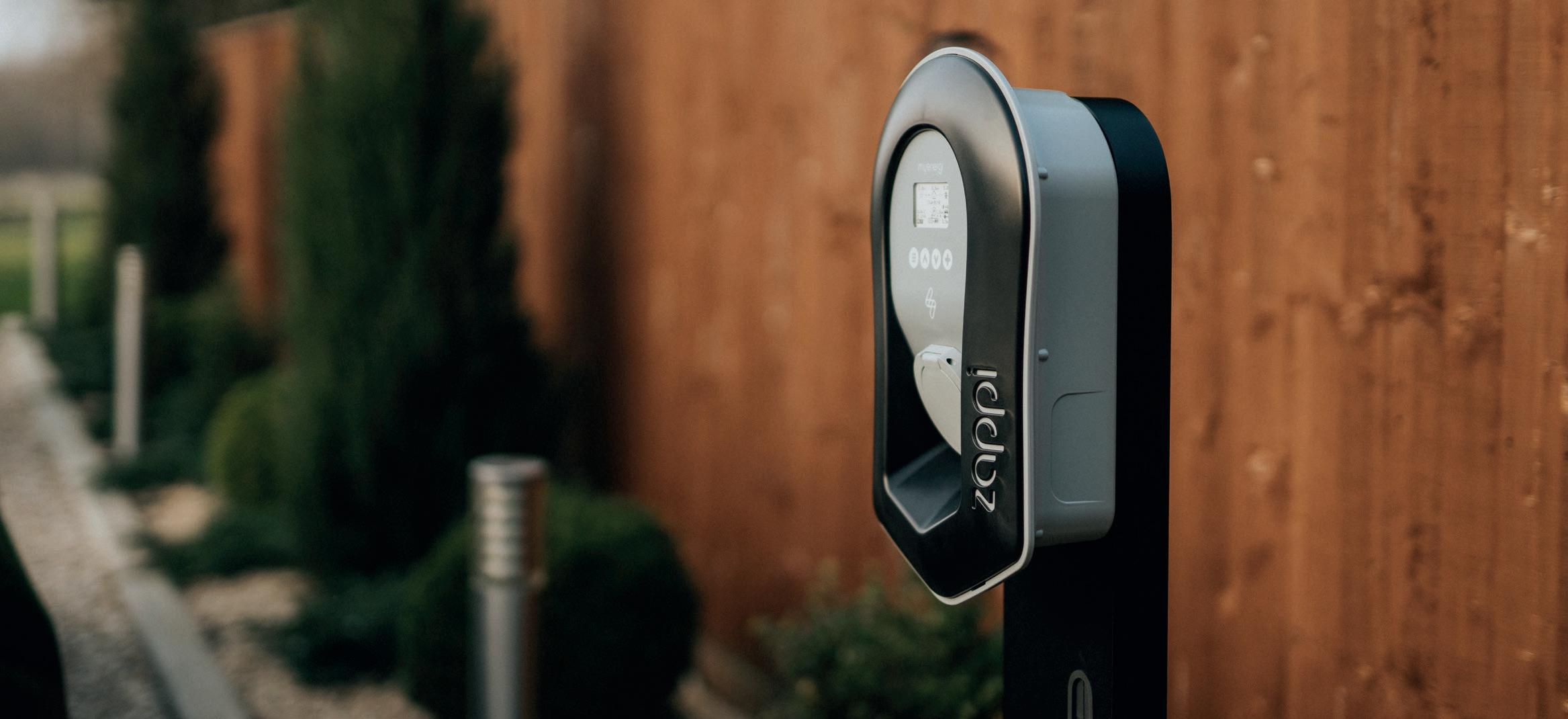
myenergi has joined other leading cleantech scale-ups, accelerators and investors in the UK to mark the launch of Cleantech for UK.
This new initiative is supported by Breakthrough Energy and organised by Cleantech Group. The initiative aims to pave the way for a new generation of global cleantech champions.

The participants were joined by Bill Gates and UK PM Rishi Sunak for the launch event at Imperial College London, where they discussed how to create the next generation of global cleantech champions in the UK.
“The UK has all the ingredients to become a major player in the global push to build our net-zero emissions future, including world-class research facilities and forward-looking investors. I am confident that the Cleantech for UK coalition will become a key bridge between cleantech investors, innovators and policy makers,” said Ann Mettler, Vice President for Europe at Breakthrough Energy.
UK cleantech venture capital investment was £3.2 billion in 2022, equalling the record-breaking amounts of 2021. This is especially remarkable in a cooling global venture capital climate. But as other countries enact increasingly ambitious
climate packages such as the Inflation Reduction Act (IRA) in the USA, and the Net Zero Industry Act in the EU, the UK must go further and faster to maintain competitiveness. The UK would have to spend a total of £36bn to reach the GDP equivalent of the IRA.
“As one of the fastest-growing private companies in the UK, it was fantastic to be able to share myenergi’s perspective on how to further accelerate growth in the cleantech sector, including a major focus on skills and training to ensure that, alongside the investments in technology we need to hit Net Zero, we are also investing in the people that we need to design, develop and install those technologies”, said Jordan Brompton, co-founder and Chief Marketing Officer of myenergi.
Cleantech for UK’s objective is to supercharge UK cleantech innovation. The UK is home to excellent scientific research and a thriving innovation scene. But this world-leading capability is not consistently translated into world-leading cleantech scale-ups.
“To secure the enormous benefits on offer to those brave enough to lead the transformation of our industrialised economies to cleaner, decarbonised and resource-efficient versions of themselves will require innovation in all facets,” said Richard Youngman, CEO, Cleantech Group. “Yes, technological, but equally in financial instruments and in policy-making. I believe a period of intense dialogue, experimentation and hyper-collaboration is needed for the UK to deliver on its net-zero goals, its economic growth ambitions, and its national security.”
Cleantech for UK is a new initiative to establish a dialogue between the UK’s policy-making community and those living the reality of creating, incubating, investing in and scaling cleantech companies. Cleantech for UK is powered by Cleantech Group and supported by Breakthrough Energy. Similar programmes in continental Europe include Cleantech for Europe, Cleantech for France, Tech for Net Zero Allianz, Cleantech for Nordics and Cleantech for Baltics.
39 NEWS
OCTOPUS ENERGY launches heat pump as cheap as a gas boiler as battle with British Gas intensifies
It comes weeks after British Gas separately announced it would fit heat pumps for as little as £2,999, kicking off a price war. Octopus currently charges £3,000 and upwards.
Installing a heat pump can currently set homeowners back by between £7,000 and £13,000 when costs such as home adaptations are factored in. A government voucher can knock £5,000 to £6,000 off the final bill.
Octopus said the overall cost of its new heat pumps will start at £2,500 when government grants are included. However, most consumers are expected to end up paying between £3,000 and £3,500, depending on the size of their home. That is roughly on par with what it costs to install a typical gas boiler – and cheaper in some cases.
Heat pumps draw warmth from outside air and run on electricity, an increasing proportion of which comes from green sources such as wind and solar power. They are seen as the future of home heating as Britain moves towards net zero. However, adoption has so far been slow because of the prohibitive cost and the home adaptations that are needed in many homes to make them effective.
Official figures show the Government’s boiler upgrade scheme only issued 7,600 vouchers out of a total 30,000 available for this financial year. The scheme was launched at the end of May 2022. A price war among major suppliers could help bring down costs. Greg Jackson, Octopus’s chief executive, said engineers have shrunk the cost of manufacturing the heat pumps, reducing the total cost to consumers.
“It’s designed to be lower cost hardware, lower cost to install and to be able to cover a bigger percentage of UK homes. It’s a serious breakthrough,” he said of Octopus’ new device.

Mr Jackson said: “At the moment, if we have to buy a heat pump, typically we are looking at £3,000 for the hardware. This will now enable us to get hold of them for £1,500.
“It’s a bunch of major leaps forward and we can keep on pushing prices downward from there.”
The new heat pump was designed by engineers at the Octopus research and development centre in Slough and staff at RED, a Northern Irish heat pump business which the company acquired last year.
Octopus has begun to manufacture the devices and plans to launch them in the second half of this year. It plans to sell the heat pumps both to its own customers and third parties.
The Government wants to rapidly increase the number of heat pumps being installed, as part of efforts to replace gas boilers to cut carbon emissions.

NEWS 40
Buying and installing Octopus’s new self designed heat pump will cost homeowners as little as £2,500.
ONE-THIRD OF UK FUNDING for insulation and heat pumps remains unspent

insulation and installing heat pumps has not yet been spent.
About £2.1bn remains unspent of the £6.6bn that was supposed to be used between 2020 and 2025 on making buildings more energy efficient and decarbonising heat. The funding is part of the £9.2bn that was promised for such spending in the Conservative general election manifesto of 2019. Insulating homes and switching from gas to heat pumps would save households money, and ease the cost of living crisis, but most people struggle to meet the upfront costs of such measures without government help.
LONDON STADIUM to be covered in solar panels to generate powerstation usage
The London Stadium is set to have multi-million pound solar panels installed to generate its own energy.
The 2012 Olympics stadium - now home to West Ham United - is to be wrapped in a solar membrane to reduce carbon emissions, it has been revealed.
It is estimated the project will cost £4 million over the first two years but would pay for itself after five years.
According to planning documents, the work could start on the east London site later this year.
The building could then start generating energy by end of 2024, according to the stadium’s owner, the London Legacy Development Corporation (LLDC) - a body set up after the 2012 Games to manage the development of the area around the Queen Elizabeth Olympic Park in Stratford.

A contract for the project’s installation said the scheme offers a “fantastic opportunity to showcase cutting edge technology”.
It added that the “key driver” for the project was to significantly reduce carbon emissions, in line
with the mayor of London’s commitment to turn London into a “zero carbon” city by 2030.
The idea has been praised by Sadiq Khan, with City Hall agreeing to contribute £45,000 towards a feasibility study and business case for the project.
LLDC’s latest budget documents state the new technology could generate roughly three million kilowatts of power each year.

Stuart Dossett, senior policy advisor at the environmental think tank Green Alliance, said: “It’s great to see such an iconic building, the scene for so much national pride, leading us into our greener future.
“Solar can be built quickly to produce cheap and clean energy to power our buildings. The sooner we expand the use of renewables, the sooner we can slash bills and carbon emissions,” he said.
41 NEWS
A third of the funding pledged by the UK government for
INSIGHT 42
HOUSEHOLDS COULD BUY SHARES IN UK WINDFARMS FOR £1,000 TO LOWER ENERGY BILLS
A new energy company is offering households the chance to cut down on their bills by buying their own share of a wind farm.
Ripple energy, a new startup, allows households and businesses across the country to own small shares of large-scale wind farms and solar parks.
The firm has a co-operative model where the energy generated will be much cheaper than the market price.
According to Sarah Merrick, CEO and founder of Ripple Energy households who invest in building the wind farm, would receive “the low-cost green electricity that their little bit of the wind farm generates.”
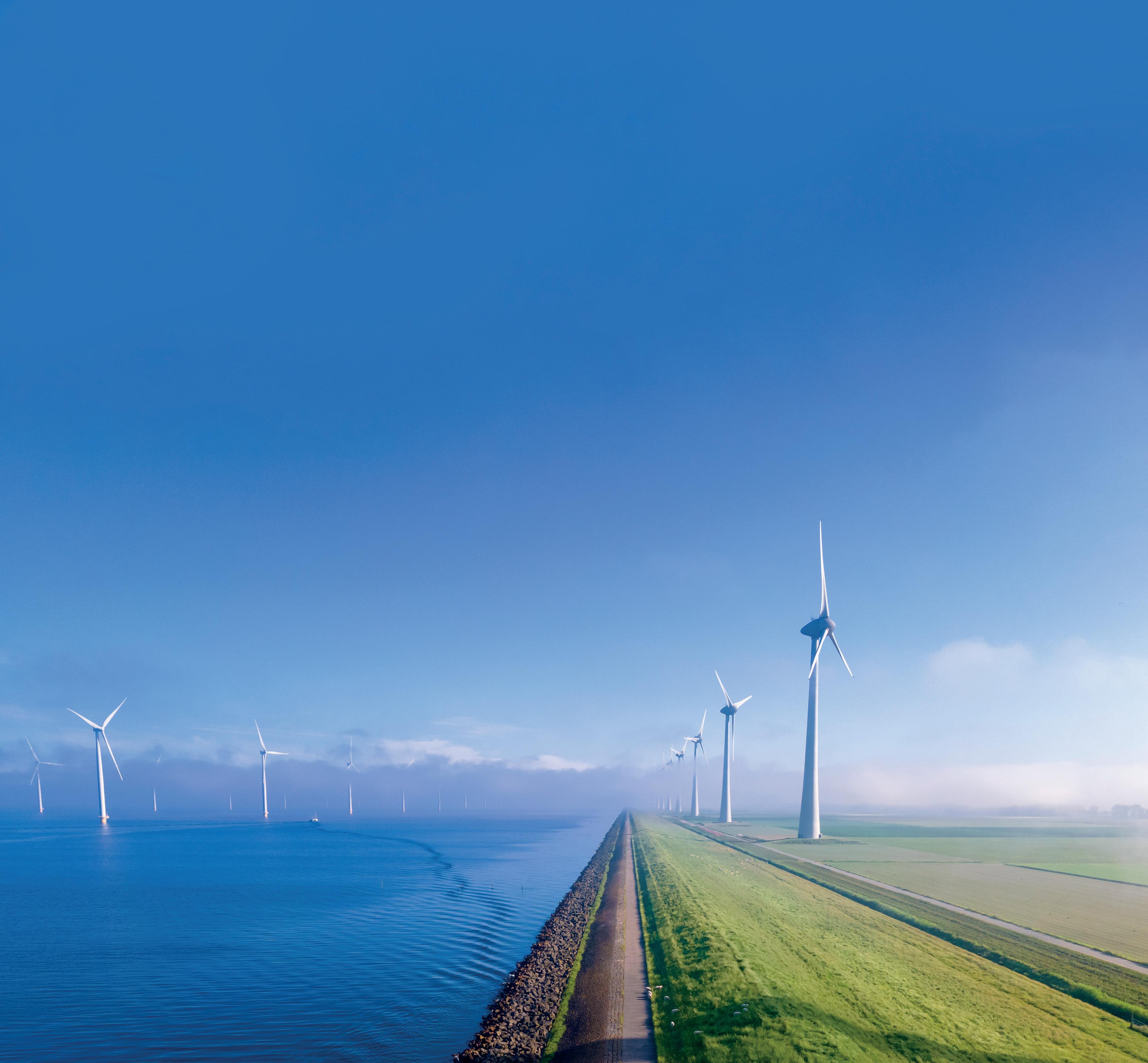
“It’s kind of an alternative to rooftop solar, instead of owning entire solar panels on your home, you own bits of large solar parks and wind farms located somewhere else in the country and you get the savings delivered straight to your electricity bill each month,” she said.
Ripple manages the co-operative ownership of the wind farm on behalf of thousands of homeowners who signed up with as little as £25. With energy bills set to rise as high as £6,000 next year, the savings earned by investing in Ripple’s solar and wind projects could pay for themselves within a few years.

Britons can invest up to 120% of their energy usage, which would save them 30% on their bills.
Ms Merrick explained that as the energy cost increases in the market, the savings earned by owning a wind farm would keep growing. She explained: “It’s really flexible, it depends on how much you need, all the way up to 120% of your electricity needs each month.
“A typical household that uses 2,900kwh per year, if they wanted their windfarm to generate as much electricity as they use, for our last project that would cost about £1,700, and then that would generate 2900kwh. On current levels of savings, they would save around £275 pounds per year, although we’re expecting next year as prices are so high, we’re expecting it to top £1,000.”
In 2020, the company launched their first wind farm, Graig Fatha in Wales, which had one turbine that was owned by 900 consumers, and one business. Their upcoming wind farm, is much larger, consisting of eight turbines in Scotland, and was signed up for by 5,600 households and 18 businesses.
Ms Merrick added: “It’s a completely new way of doing electricity, it can put consumers in a lot more control of their energy than they previously were. Our big mission is to make clean energy ownership affordable and accessible for everyone.”
Britons can invest up to 120% of their energy usage, which would save them 30% on their bills. ”
“
OVO PLEDGES SUPPORT FOR COMMUNITY ENERGY PROJECTS TO HELP PUSH FOR NET ZERO
VODAFONE SIGNS SOLAR PPA COVERING
ITS UK ENERGY REQUIREMENTS
Vodafone has signed a major corporate solar power purchase agreement (PPA) in the UK. The deal gives Vodafone access to clean, high quality and affordable renewable electricity in the UK for the next ten years, offering price certainty and improved energy security.

Community Energy England (CEE), a not for profit organisation, represents 310 community energy businesses and other stakeholder organisations who are delivering community-led renewable energy, energy demand reduction and energy advice services across England.
Through its principal supporter role, OVO aims to help projects secure additional revenue, by providing community energy organisations access to subsidy-free power purchase agreements (PPAs), which could make the difference between renewable energy developments going ahead or not.
OVO was the first supplier to commit funding to specifically support subsidy-free generation, designed to incentivise small-scale, independent wind and solar farms by offering an above-market price for the electricity they generate.

CEE says the initiative’s aim is to “create a thriving market that will directly drive new investment in renewable assets in the UK, supporting the UK’s net zero goals”.
The announcement follows the news of two deals to power thousands of homes. Last month, OVO signed two PPAs with new subsidy free onshore
wind generators. It has also signed contracts to buy renewable electricity from Genatec’s Pond Farm Wind project and Ambition Community Energy C.I.C.
Stephen Harris, VP of Energy, OVO Energy, said: “We’re committed to supporting investment in renewable energy generation and community projects across the UK. I am delighted to partner with CEE and support new independent renewable generation, supporting the UK’s net zero goals and removing our reliance on a fossil fuel dominated energy system.”
Philip Coventry, head of operations at CEE, said: ”We’re looking forward to helping the OVO team with their initiatives to support the growth of community energy by providing the sector with more investment and enhanced levels of support. With ongoing cooperation we are confident that OVO’s engagement with community energy will facilitate new opportunities that will benefit the whole sector and its growth.”
In Europe, 100% of the grid electricity we use is matched with renewable energy certificates. Combined with agreements already in place, this new solar PPA means around 44% of our annual energy requirement in the UK will come from UK-based renewable power sources by 2025.
As part of the deal between Vodafone, Centrica as the power supplier and MYTILINEOS as the generator, five solar farms located in Norfolk, Nottinghamshire, Staffordshire, Buckinghamshire and Dorset, will generate 216 gigawatt hours of electricity and displace more than 53,000 tonnes of CO2e emissions each year. That is the equivalent of taking around 31,400 cars off the road. The solar farm builds will start in 2023, with energy generation expected from early 2024.
Vodafone will purchase a significant proportion of the electricity generated by the farms, securing their development and bringing additional power provision to the UK grid. The remainder will be sold through Centrica’s Energy Marketing & Trading business.
The news follows an announcement from Vodafone UK last year to purchase a significant proportion of power from three new UK solar farms. The first of these is now fully operational, with the others to follow in the coming months. Combined with two onshore wind farms, in Northamptonshire and Lincolnshire, we have secured access to renewable power from 10 sites across the UK.
43 INSIGHT
MORE THAN 40% OF
OVO has joined Community Energy England’s membership as a principal supporter, saying it will offer enhanced levels of support for community-led renewable energy projects.
20 WAYS TO REDUCE ENERGY USE AND LOWER BILLS HOW TO SAVE ENERGY AT HOME

Knowing how to save energy at home is crucial. It can save you money because your energy bills will be lower, and you’ll be playing your part in reducing the use of fossil fuels and mitigating the effects of climate change.
We’ve also asked the experts to share their advice on energy conservation –and thus saving money – as well. So, whether you live in an older house or a newer one, discover the ways to save energy at home.
SWITCH ENERGY SUPPLIER
Some electric utility customers have the option to choose an alternate electricity supplier, according to the US Energy Information Administration. The way to find out if this is a possibility? Contact your distribution utility or the utility regulatory commission (opens in new tab) in your state.
Whether your home is old or newer, there are plenty of ways to save energy. The rewards? Lower bills and a home that makes less impact on the planet.
In the UK, you could be overpaying for your energy if you haven’t switched suppliers recently – or ever. Sadly, loyalty doesn’t pay off when it comes to staying with the same provider for years. Use our energy comparison tool to find out if you could save.
Using a smart meter to cut down on energy use.
CONDUCT A HOME ENERGY AUDIT

You can call in a professional to find out how to save energy at home, but you could conduct your own home energy audit, which will provide useful information whatever type of home you live in.

Look for air leaks, check insulation, and inspect heating and cooling equipment, which should take place at least once a year or according to the manufacturer’s recommendation.
FILL GAPS BETWEEN FLOORBOARDS
Filling gaps between floorboards is one of the top energy saving ideas for owners of older homes. Old floorboards add character to a room, yet it’s astounding how muchheat can be lost through the gaps between them: added up together it can be the equivalent

of a small window being permanently left open.
While simply laying down a large area rug in winter can provide extra insulation, learning how to fix drafty floorboards is a DIY skill worth having under your belt, and offers a better solution long term.
SWAP TO LED LIGHTING
Energy for lighting accounts for around 10 per cent of your electric bill so an easy way to adopt better energy conservation measures and lower your spend is by updating light fittings and swapping to light-emitting diodes (LEDs),

which can instantly reduce consumption of electricity.
While LED lamps can be expensive to buy, on average these last 25,000 hours, and savings in electric bills will usually offset the cost.
TOP 20 ENERGY TIPS 44
HAVE MORE CONTROL WITH SMART LIGHTING
While investing in a smart lighting system means making a slight initial investment, you’re sure to make a saving – both cost and energy wise – in the long term. Particularly if you’re switching over directly to more efficient bulbs or simply investing in smart plugs in order to control and monitor your plugin appliances’ energy usage.
In addition to being one of our favourite energy saving ideas, we like smart lighting buys because they help users streamline their lighting system. That’s thanks to the option to control all the lights in your home from your smartphone. There are a whole host of smart lighting gadgets to pick from but the Philips Hue Starter Kit is a great place to get started.

REVIEW YOUR HEATING AND COOLING SYSTEM
A yearly professional check and cleaning of heating and cooling equipment is important. It’s also vital to check the filters of a forced-air furnace and replace them as needed.
In the UK, meanwhile, if your home heating system is powered by a boiler an annual service is important to ensure it is working as well as it should. But if it’s more than 10 years old you should consider replacing it with a highly efficient condensing model, which can save you up to £300 per year or

look at alternatives like an air source heat pump.
If your radiators aren’t working effectively, check to see if they are colder at the top than at the bottom, as this means there could be trapped air in the system. Learn how to bleed a radiator – it’s a straightforward task that can be done on a DIY basis.
If, however, the top of the radiator is hot and the bottom cold, or generally they aren’t that warm, then there is probably sludge in the system that needs flushing out – a process that usually costs around £500.
DRAFT-PROOF DOORS AND WINDOWS
When you’re focusing on how to save energy at home, you can make good wins with simple improvements, and one of these is fixing air leaks, including those from doors and windows.
Use caulking to seal leaks due to cracks and gaps where the components are stationery. Where they move, go for weatherstripping instead.
It’s also worth considering replacement of old drafty windows and doors for improved energy conservation. Look for those with Energy Star and NFRC labels.

INSULATE THE LOFT
Whichever type of climate you live in, insulating your loft is vital as part of a plan about how to save energy at home.
In the UK, the most widely used material for loft insulation is mineral wool (around 27cm to 30cm deep) as, at around £20 per roll, it is very cost-effective. Although unpleasant to fit, requiring the

‘Installing windows that are catered to your region’s climate and directly serve your home’s needs allows your thermostat to take a break and achieve your desired temperature without extra work,’ says Keith Gutterman, VP of marketing and business at Storm Tight Windows.
Sash windows can also be an issue due to the necessary gap around the sliding mechanism, but in the UK specialist companies such as Ventrolla and The Sash Window Workshop can add discreet draft-proofing. It’s possible to restore and maintain timber windows in old homes as well as maintain and repair metal framed windows.
use of protective clothing, mineral wool has good fire resistance and sound-insulation qualities.
Natural materials, such as sheep’s wool quilt or loose cellulose (made from recycled newspaper) are nicer to work with and well suited for use in older houses, but also consider a breathable spray foam insulation such as Icynene.
ADD SMART HEATING CONTROLS
Smart thermostats can help you save an unbelievable amount of energy – and money – on an annual basis, and it’s worth getting savvy about what a smart thermostat is.

With the best smart thermostats
capable of learning your heating and cooling behaviours – and consequently how best to streamline them – they’re perfect for reducing your energy bill. What’s more, you’ll be able to see your saving thanks to monthly reports.
Not only can old window frames be the cause of drafts, but the glazing is often single pane.
If you take this route, make sure you opt for low-e storm windows. These have a low emissivity coating on the glass which reduces heat transmission. Fit these and savings

FIT STORM WINDOWS
of between 12 and 33 per cent on heating and cooling costs can be achieved. You could look at fitting secondary glazing which also cuts down on road noise, and the panels are usually very discreet and can be opened when needed.
INVEST IN A HEAT PUMP
The most commonly used type of heat pump is an air source heat pump, but there are also water source and geothermal options. If your home doesn’t have ducts, you can opt for a ductless version of an air source heat pump which is called a mini-split heat pump. While renewables can give considerable sav-

ings on your bills, they can also have a negative impact on your home’s appearance, so make sure you have all the facts before investing.
In the UK, if you’re not able to generate your own renewable energy, it’s now quite easy to switch to one of the best green energy suppliers without needing to install anything in your own home.
INSTALL AN ENERGY-EFFICIENT STOVE
Unlike open fires, which lose most of their heat straight up the chimney, wood-burning stoves are sealed to the room.
Choosing a wood burner idea over an open fireplace will result in you using

less fuel and radiates the heat throughout the room efficiently. They’re a perfect solution if you’re looking for ways to make an old home more energy efficient.
TRY A CHIMNEY BALLOON
An inflatable chimney balloon can be a great way to seal it when it’s not in use to stop warm air escaping. Don’t use the fireplace at all? You can plug and seal the chimney flue.
You can also try a device such as the
Chimney Sheep to stop drafts. Made of a thick layer of felt, it can be inserted up the chimney when the fireplace isn’t in use and simply removed when you want to light a fire. If the fireplace is never used, you could opt for a chimney balloon instead.

INSULATE THE WALLS
When you’re thinking about how to save energy at home, investigate the potential of wall insulation.

In an uninsulated house, around a third of the heat will be escaping through the walls, so adding the right type of insulation can have a huge impact on the overall comfort of your home. If your property was built after around 1920, it’s likely that you’ll have cavity walls, which means you can have insulation injected into the empty space between the inner and outer brickwork. As this can usually be done externally, there’s mini-
mal disruption to the property. According to the National Insulation Association, adding cavity wall insulation to a semi-detached home will cost around £475. Depending on the size of the house, internal wall insulation will range from £4,000 to £13,000, and external wall insulation from £8,000 to £22,000.
What will you save? Adding cavity wall insulation to a semi-detached home can save you up to £155 per year, and solid wall insulation can save up to £260 per year, according to research from the National Insulation Association.
THEN INSULATE THE FLOORS, TOO
You could make your rooms more comfortable as well as save energy with the right floor insulation.
How you approach the job will depend on whether it is a solid or suspended floor. A suspended wood floor needs both thermal in-
sulation and draftproofing. A solid floor made from concrete might be improved with the help of insulating foam boards, or a floating wood floor or thermal underlay with a carpet.
For traditional solid floors, coir or other breathable floor coverings can help.
REFLECT HEAT FROM RADIATORS
Home with radiators? Fit enhancers behind them to reflect heat back into the room. In addition to preventing heat loss through the walls, this can save on energy bills and these are cheap to install.

You should make sure you keep them clean, too. ‘If your radiators aren’t in your weekly
cleaning routine, then it’s time to add them,’ says Jordan Chance, heating expert from PlumbNation. ‘A buildup of dust can affect your health, allergies and your heating bill. Layers of dust in your radiator can prevent heat from escaping effectively, meaning your radiators will have to work harder to warm your room.’

GET CLEVER WITH CURTAINS
Opting for curtains with a thermal or blackout lining can significantly reduce heat loss especially if you have single pane windows.
‘For best results, I suggest hanging the curtain rod at least 2 to 3
inches above the window frame and 2 to 3 inches to the outside of the window frame,’ says Angela Boswell, co-founder of The Drape. ‘This extends the barrier around the window to protect your interiors and energy bill.’

INSULATE FLOORS OVER A GARAGE
It’s a good idea to insulate floors above an unheated garage as part of your garage insulation strategy. ‘Installing continuous air and thermal barriers between an unconditioned garage and the conditioned spaces

above can save energy and money, improve comfort, and safeguard indoor air quality,’ says the US Department of Energy.

Make sure you deal with any air leaks before you fit insulation, though.
TRY SMALL SPACE HEATERS
Particularly in larger properties, heating the whole house when you’re using only one room – say a home office – for the majority of the day is not energy efficient.
To keep the room warm while you’re working from home, consider getting a small.
GO DARK WITH EXTERIOR PAINT
Think about the paint colors or render you use for the exterior of your home to save energy.

‘For the exterior, dark colored paints are good if you live in a cool
climate,’ says Phillip Ash, founder of Pro Paint Corner. ‘Dark paint will absorb heat and keep your home warmer. If you live in a warm climate, go for the light paint.’
ENERGY SAVING MYTHBUSTERS
This is a very common myth. But in fact, you really don’t need to be heating your water all the time. Your immersion heater or boiler will heat up hot water which is stored in a tank. As long as the tank has a good insulating jacket, it will keep the water hot all day, without needing to be constantly reheated. You can use a timer to heat your water for an hour or two each day just before you would usually need hot water for baths or showers. Modern washing machines, dishwashers
and electric showers take cold water and heat it themselves so you don’t need a supply of hot water waiting for them in the tank.
If you’re on Economy 7, make sure your electric immersion tank is coming on for a couple of hours in the night when you are getting electricity at a much cheaper, off-peak rate.
YOU SHOULD LEAVE THE HEATING ON ALL DAY, RATHER THAN TURNING IT ON AND OFF
Another common myth. Don’t pay for heat that you’re not using! If you are out during the day (or tucked up in bed at night), you don’t need the heating on. Even if you turn your thermostat down a bit, your boiler will keep firing up and using energy (and cost you money) at times when
you won’t feel the benefit. Instead, programme your central heating using the timer so that it switches off when you’re out or in bed, and switches back on to warm up the house about half an hour before you get home or before you get up.

TURNING THE THERMOSTAT UP WILL HEAT THE HOUSE UP FASTER
Myth. If you come home to a cold house, it’s tempting to whack the thermostat up in the hope that this will make the place warm up faster. Sadly it wont; your boiler works at the same constant speed regardless of whether you set your thermostat to 20C or 30C. In fact, you’re likely to find that later in
the evening you’ll be sweltering – and wasting a lot of money – as your boiler doesn’t stop when the room is comfortable. Set the thermostat to a sensible room temperature, between 18-21C, and then leave it alone.

MYTHBUSTERS 48
We hear a lot of suggestions for saving energy that are simply not true. Here are some of them...
IT’S BETTER TO LEAVE THE HOT WATER HEATER ON ALL THE TIME, RATHER THAN TURNING IT ON AND OFF
IF I TURN ALL THE RADIATORS DOWN LOW, I’LL SAVE MONEY
True. But only if you also turn your thermostat down at the same time. If you turn your radiators down low but still have the thermostat set to 21C, your boiler will keep running until the room temperature reaches 21C – and this will take a long time with the radiators on low. So if you want to save money and are comfortable with your house a little cooler, make sure you turn down the thermostat, not just the radiators.
The point of thermostatic radiator valves (the ones with numbers on that you can turn up and down) is to set different rooms to different temperatures, so that you’re not wasting money heating rooms you aren’t using.
And it’s not a good idea to turn a radiator off permanently in an unused room, as this can lead to damp and mould. Leave them on low instead, and close the doors.
IT’S CHEAPEST TO STAY IN ONE ROOM WITH AN ELECTRIC HEATER OR A GAS FIRE

Sometimes true. It might seem obvious that if you’re alone in the house and cold, you’re better off sitting next to a heater in one room than turning the central heating on. This can be untrue, depending on what type of heater you use. Electricity and bottled gas are both far more expensive per unit than mains gas. Electric fan heaters and portable gas fires are two of the biggest energy guzzlers,
and if you have them on for a matter of hours then it may be cheaper just to turn on your central heating with the radiators on a low setting in the rooms you’re not using. However, oil filled radiators can be a good option for heating one room, particularly if you have a large property or your boiler is old, or you don’t have thermostatic radiator valves (TRVs). Here’s how much energy portable heaters use.
NIGHT STORAGE HEATERS ARE EXPENSIVE TO RUN AND/OR DON’T WORK
Potentially true if you don’t know how to use them properly. Lots of people have gripes with night storage heaters, but if you understand how to use the controls and you’re on the Economy 7 electricity
tariff, they are the cheapest form of electric heating. If you don’t understand how the controls work then you can quickly run out of heat so it seems as if they aren’t working, or they can charge up with more heat than you need and become expensive to run. Read our simple guide here before you despair.
Myth. This old chestnut is almost completely untrue, and is probably causing lots of people to waste money on lighting. It doesn’t take any more electricity for a light bulb to turn itself back on. If it’s on, it’s using electricity, and if it’s off, it isn’t. Modern low-energy light bulbs do use a small amount
IT TAKES MORE ELECTRICITY TO TURN LIGHTS OFF AND ON AGAIN THAN TO LEAVE THEM ON DISHWASHERS USE A LOT OF ENERGY
of extra energy when you first turn them on, as do florescent strip lights. But with both of these, if you are leaving a room for more than a couple of minutes then turn the light off and you’ll save money.

Myth. Perhaps your gran believed this and insisted on washing up by hand instead so as not to waste electricity. But it’s not really true – in fact, if you do a full load and select a medium temperature on your dishwasher, it can use
less energy than doing the washing up by hand. You need quite a lot of hot water to hand-wash the same number of plates. Many dishwashers have an economy setting which will use even less electricity and water.
49 MYTHBUSTERS
GOVERNMENT ISSUES £3.1MILLION OF CONTRACTS TO ACCELERATE UK FUSION INDUSTRY
Eighteen organisations have secured contracts with the United Kingdom Atomic Energy Authority (UKAEA) to demonstrate how their innovative technologies and proposed solutions can help make fusion energy a commercial reality. The organisations will focus on overcoming specific technical and physical challenges.

The contracts – feasibility studies from £50,000 up to £200,000 – are funded by the UKAEA’s ‘Fusion Industry Programme’ and awarded through the UK Government platform ‘Small Business Research Initiative’. The latest contracts are the second part of the Fusion Industry Programme, following the first cycle of the Fusion Industry Programme in 2021.
The projects aim to tackle specific challenges linked to the commercialisation of fusion energy, from novel fusion materials and manufacturing techniques through to innovative heating and cooling systems, all needed for future fusion powerplants.
Tim Bestwick, UKAEA’s Chief Technology Officer, said: “In the past 12 months we have seen significant advances both in the UK and globally that demonstrate the potential for fusion energy to be a safe, low-carbon and sustainable part of the world’s future energy supply. However, there are a number of significant technical challenges to address for fusion energy to realise its potential. The Fusion Industry Programme is helping engage organisations
and industrial partners to stimulate innovation and address these important challenges.”

The Fusion Industry Programme is part of the Government’s £484 million support package for UK research, announced last year. The Programme was allocated £42.1 million as part of this package to stimulate innovation and to accelerate the development of the fusion industry.
Contracts have been awarded to start-ups, smallmedium enterprises, established companies, and academia, with six of the eighteen organisations receiving funding through the Fusion Industry Programme for the first time (see below for the full list).
As a growing industry, knowledge transfer from other technical and engineering sectors is vitally important to the fusion industry. Collaborating with wider industry allows a collective approach to tackling climate change issues and faster access to energy security.
The Fusion Industry Programme was launched in 2021 to drive long-term economic growth by developing technology and skills that can both support domestic programmes and be exported globally.
Fusion energy is sometimes described as the ultimate energy source, based on the same processes that power the sun and stars. It has the potential to provide ‘baseload’ power, complementing renewable and other low carbon energy sources.
INSIGHT 50
Campaigners fear government will drop onshore windfarm promise in England
Fears that the government is quietly planning to renege on promises to lift the ban on onshore windfarms in England have prompted a large group of green campaigners, business leaders and prominent figures to protest to ministers.
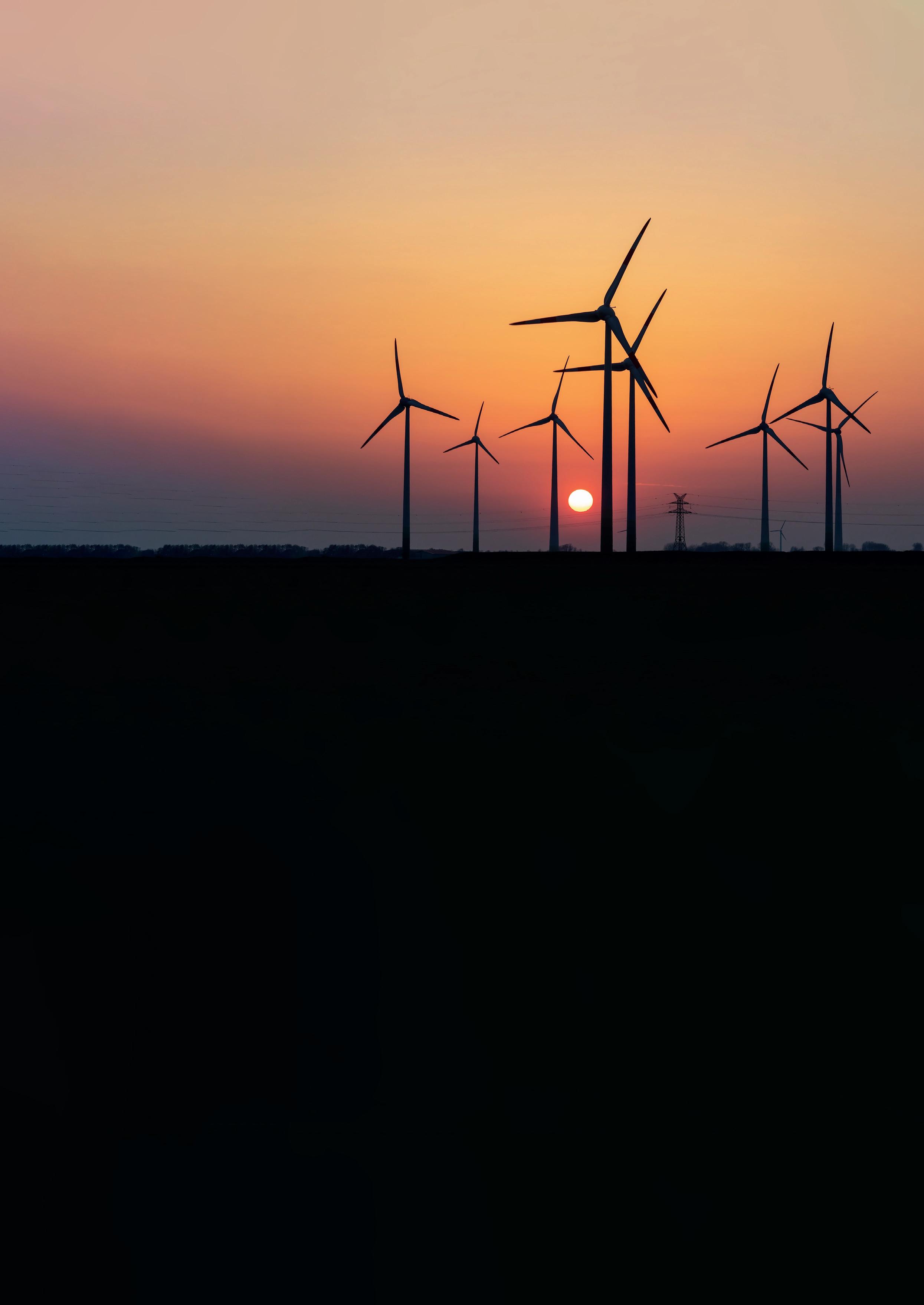
Hugh Fearnley-Whittingstall, the chef and environmental campaigner, has led a letter to secretaries of state, signed by conservation groups, academics and business people who are concerned that the pledges to free up planning restrictions are being quietly subverted.

The effective ban was put in place in 2015 by tightening planning restrictions in the National Planning Policy Framework. To end the ban, the relevant planning regulations should be scrapped or clearly reformed.
But the signatories to the letter believe that ministers will instead offer only minor changes that will still prevent onshore windfarms from being built.
The campaigners fear that by hiding behind obscure footnotes in the regulations, the government will be able to retain the restrictions in effect, while claiming to have reformed them.
Fearnley-Whittingstall said: “Poll after poll makes it clear there is an overwhelming public majority in favour of onshore wind, and communities are standing by with great wind-power projects that they know will help the environment and bring down their energy bills. Yet the government apparently just doesn’t get it. They are not only totally out of sync with the people on onshore wind, they are floundering on their own commitment to net zero.”
The letter warns: “The proposed changes to the National Planning Policy Framework which are currently under consultation are entirely inadequate to bring about the required change in policy. The decision to replace [paragraph 158] Footnote 54 with some marginally revised wording, in the form of new Footnotes 62 & 63, looks to be almost identical
in effect, and inevitably means the effective ban will remain in place.”
The footnotes refer to a clause in the framework that effectively excludes onshore windfarms. The signatories called for the removal of these footnotes, to place onshore wind planning applications on the same planning basis as other onshore infrastructure projects. The signatories went on: “Let’s end a policy that hampers both climate progress and energy security and open up the possibility of wind power across England.”
The 116 signatories include former chief scientific adviser Sir David King, former food adviser Rosie Boycott, broadcasters including Kevin McCloud, Chris Packham and Liz Bonnin, business leaders Deborah Meaden and Mary Portas, civil society organisations including RSPB, the Soil Association and the National Federation of Women’s Institutes. Asked whether the government was planning to end the onshore wind ban, Graham Stuart, minister for climate change, said: “We are working hard to ensure more onshore windfarms can go ahead with community support.”
Paragraph 158 of the National Planning Policy Framework refers to planning applications for renewable energy and low-carbon development, and requires local authorities to accept such applications barring major reasons not to.
But the government’s current changes would only revise “fully” to “satisfactorily”, and replace “backing” with “support”. That would not be enough to remove the ban, the letter’s signatories wrote.

Fearnley-Whittingstall said: “The government says they are consulting the public on onshore wind, but it feels like the consultation document has been made deliberately difficult to engage with and wilfully obscure. Instead of simply asking the public if they want the ban lifted so we can have more onshore wind in England, they ask them to comment on some feeble word changes in a couple of revised footnotes. It’s just pathetic.”
Nick Bruce-White, interim director of RSPB England, said: “Mindful and effective planning can ensure new onshore wind turbines are positioned away from the areas that are sensitive to wildlife. So it is unfathomable as to why government seems not to be supporting this tried and tested renewable technology to grow our clean energy supply as we look to reach a net zero power grid by 2035.”
Dale Vince, chief executive of renewable energy supplier Ecotricity, said the ban was “absurd and dishonest” as polls show most Tory voters support onshore windfarms. “We have a cost of living and energy bill crisis, not to mention a climate one – and onshore wind is the fastest, cleanest and cheapest form of energy we can build,” he said. “If it were unshackled we could reach 100% green on the grid in 10 years and with no public money. It’s dishonest because the Tories claim the ban is because onshore wind is unpopular. The truth is the country is united in support of onshore wind; recent polling shows even 80% of Tory voters support it.”
51 INSIGHT


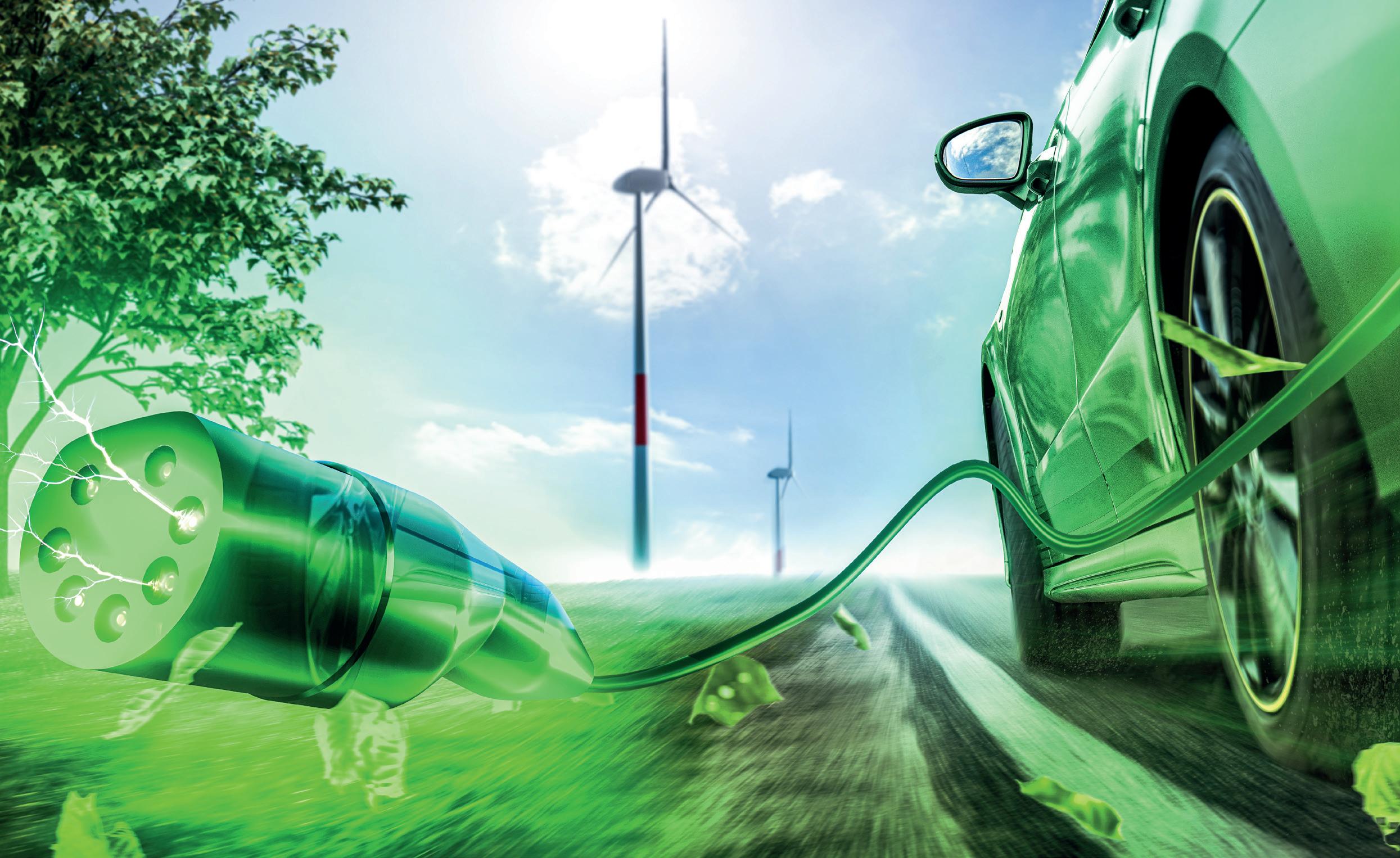

COMING IN SEPTEMBER

































 Tom Callow, Head of External Affairs for myenergi
Tom Callow, Head of External Affairs for myenergi





































































 Scan this QR code to watch a full, indepth review on EV Powered’s YouTube channel
Scan this QR code to watch a full, indepth review on EV Powered’s YouTube channel


























































